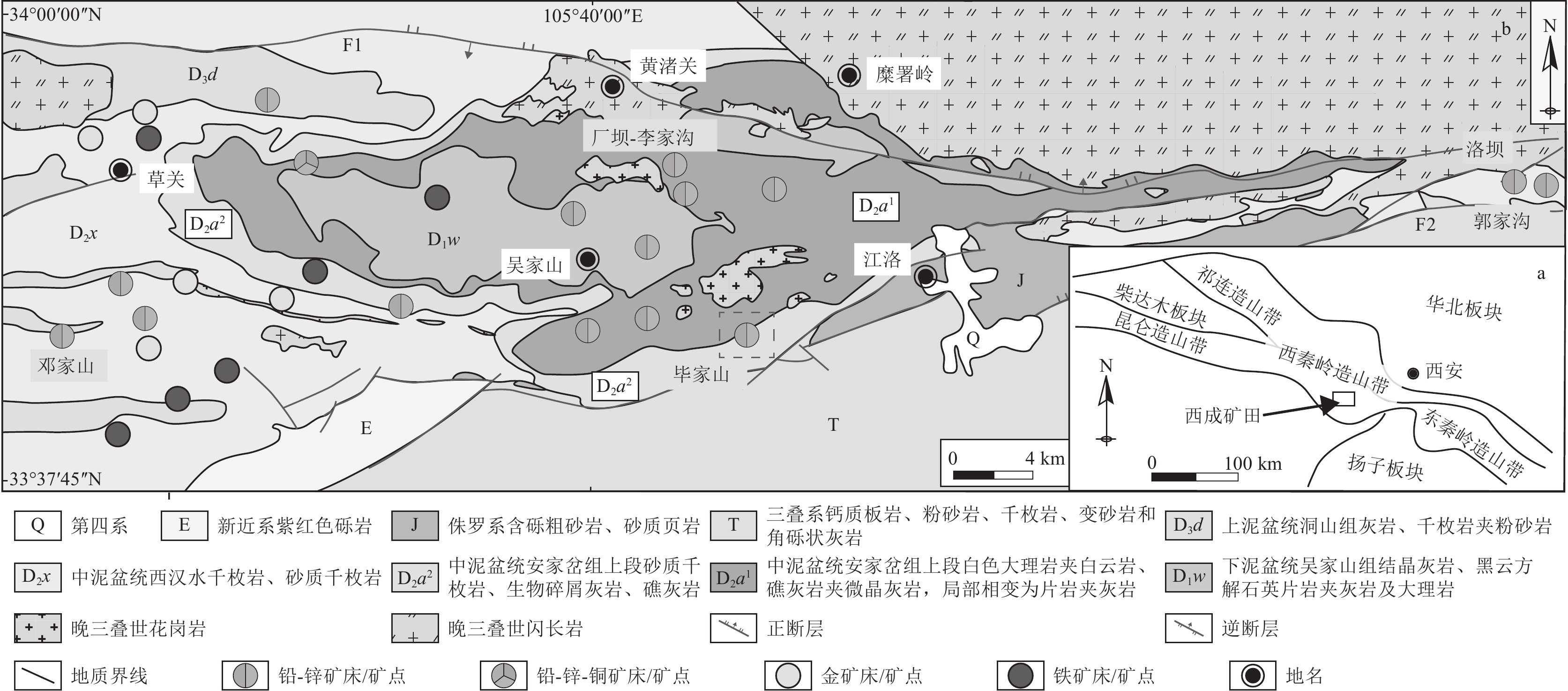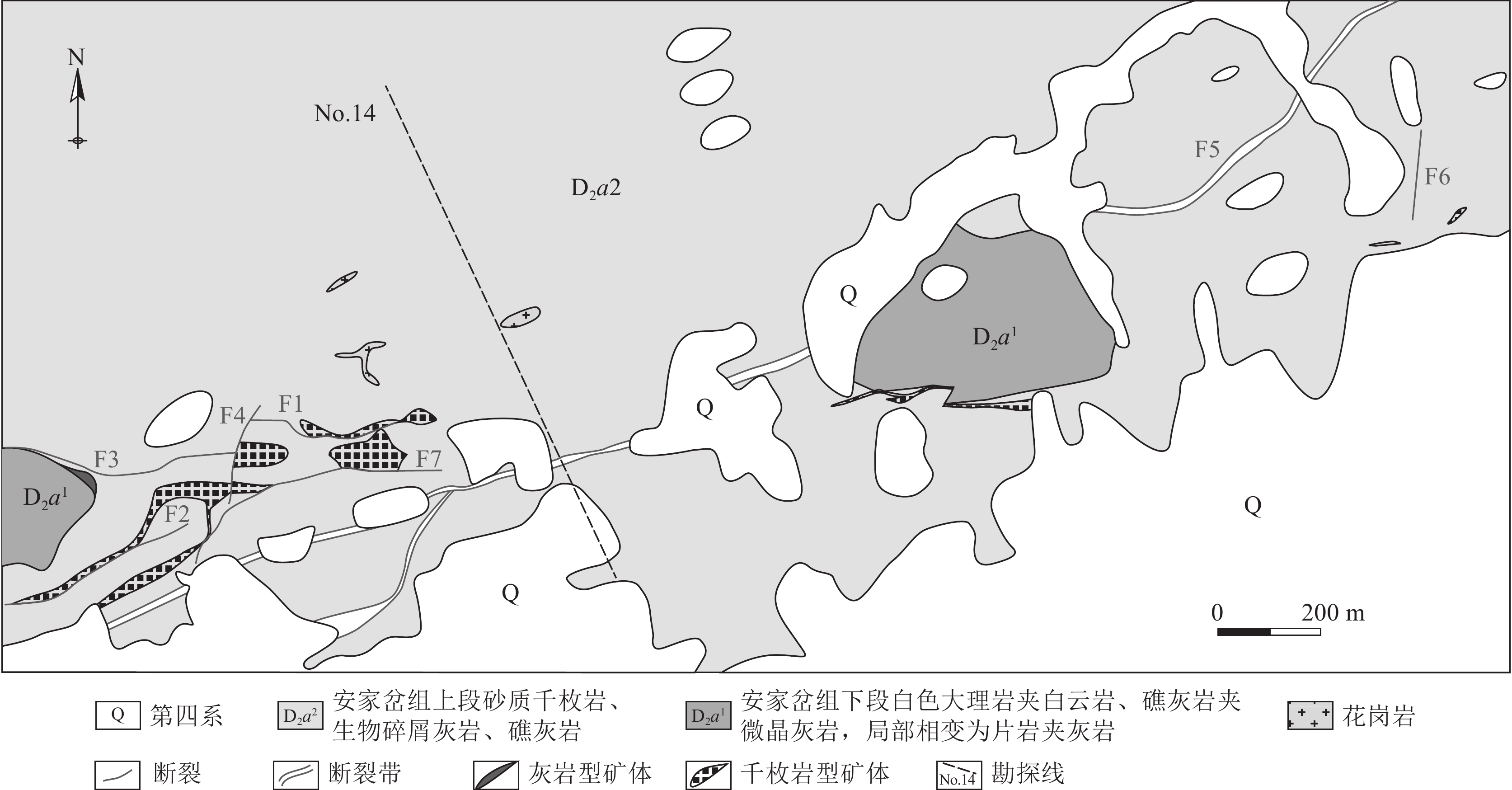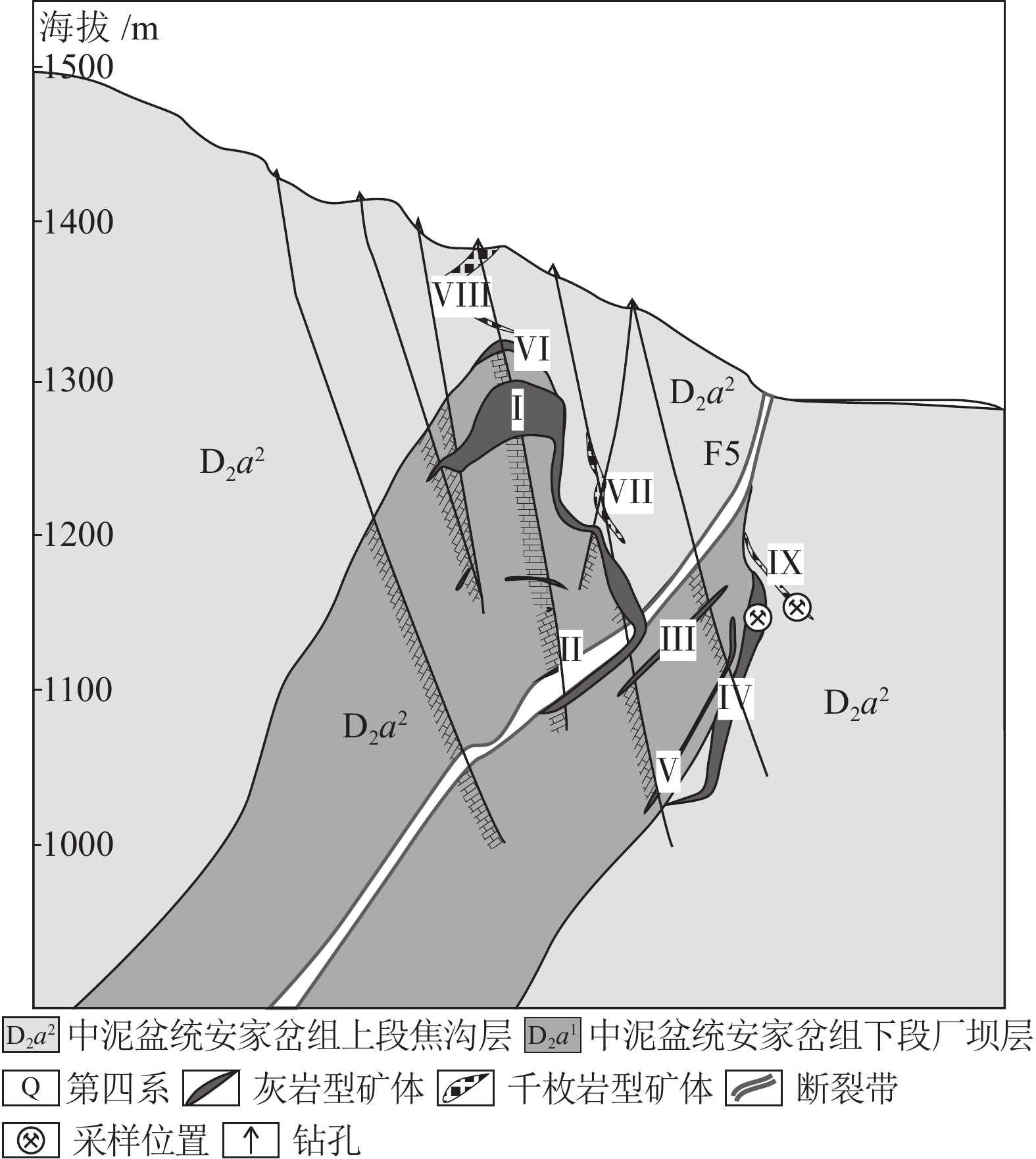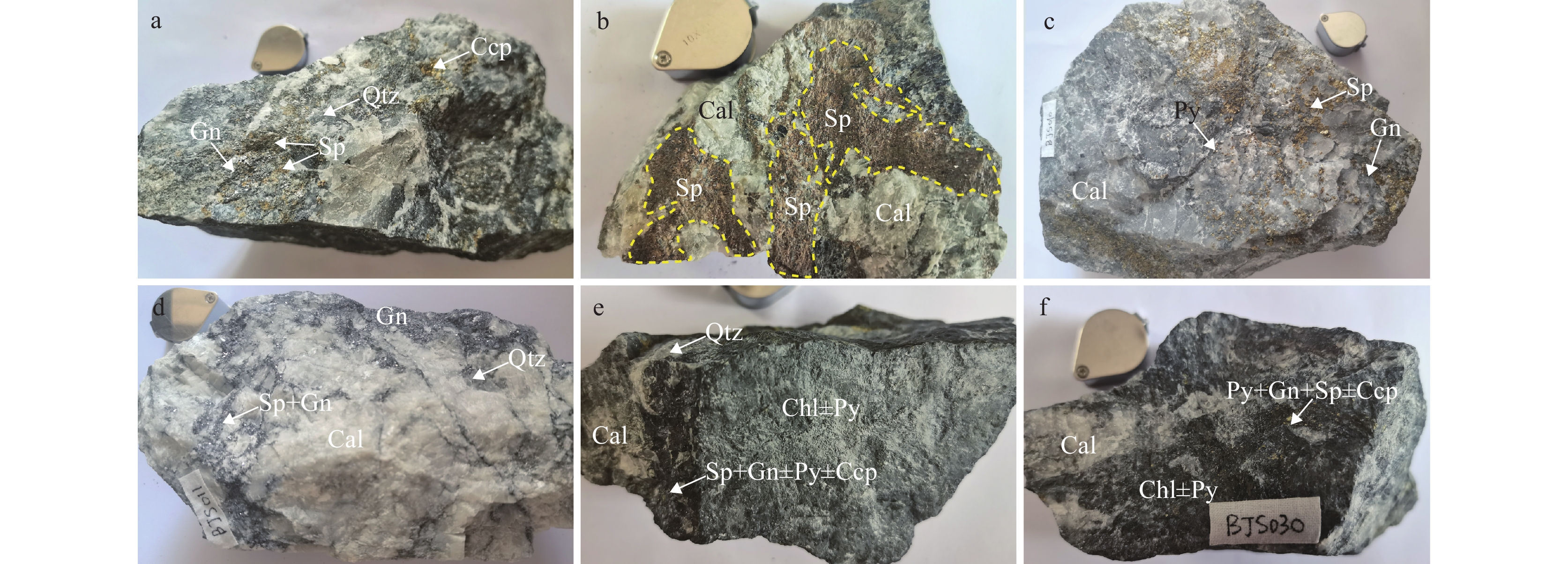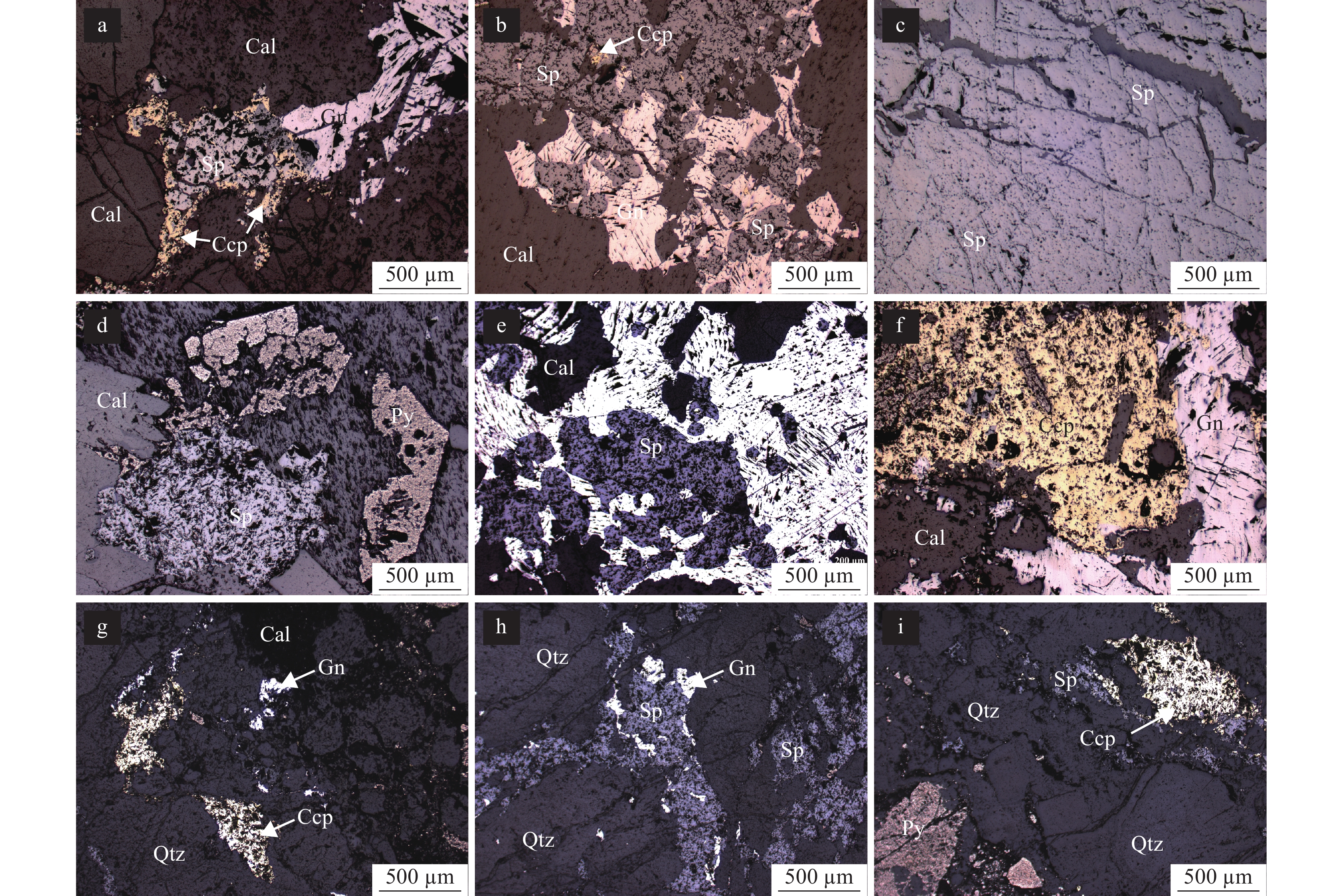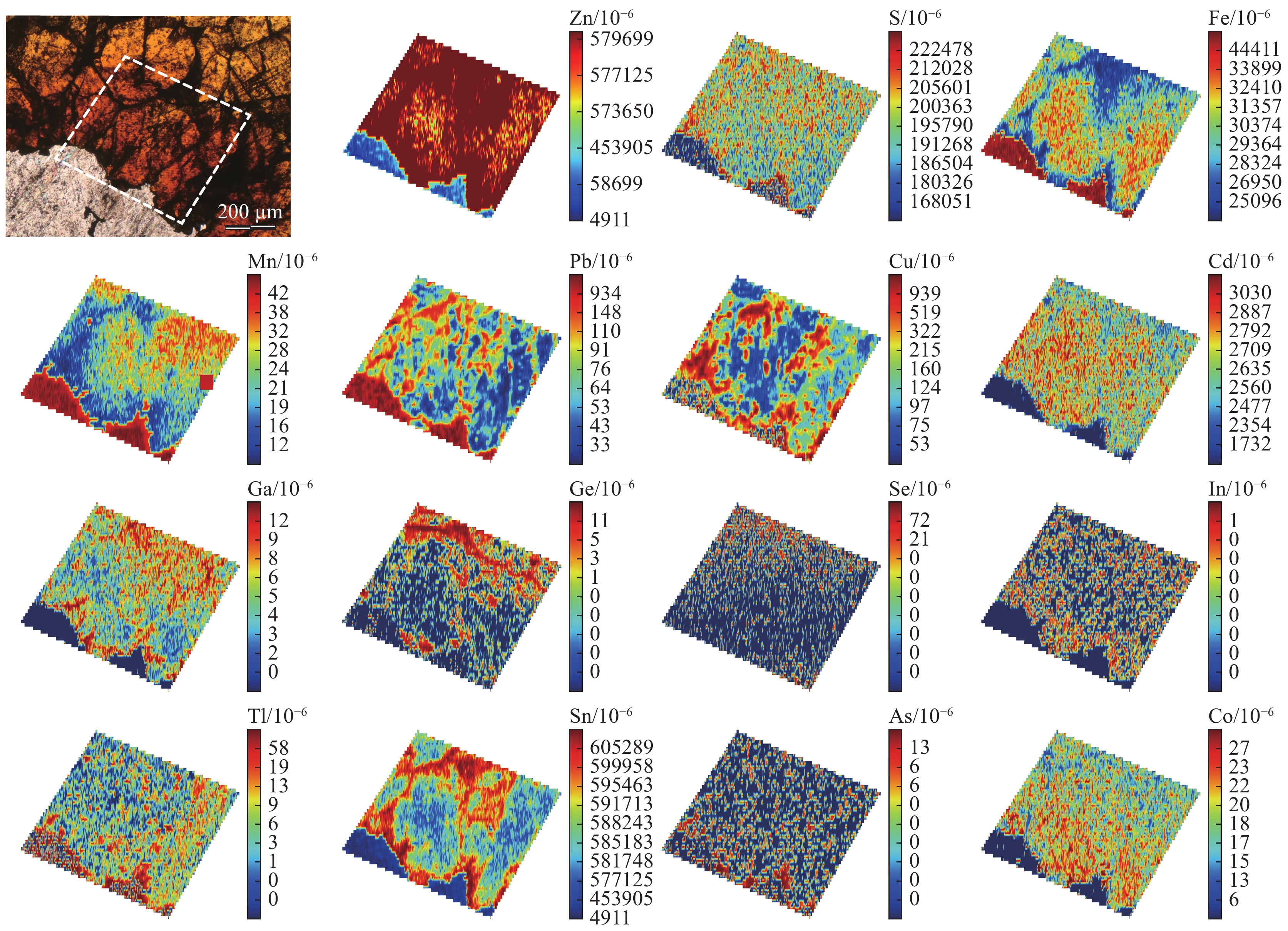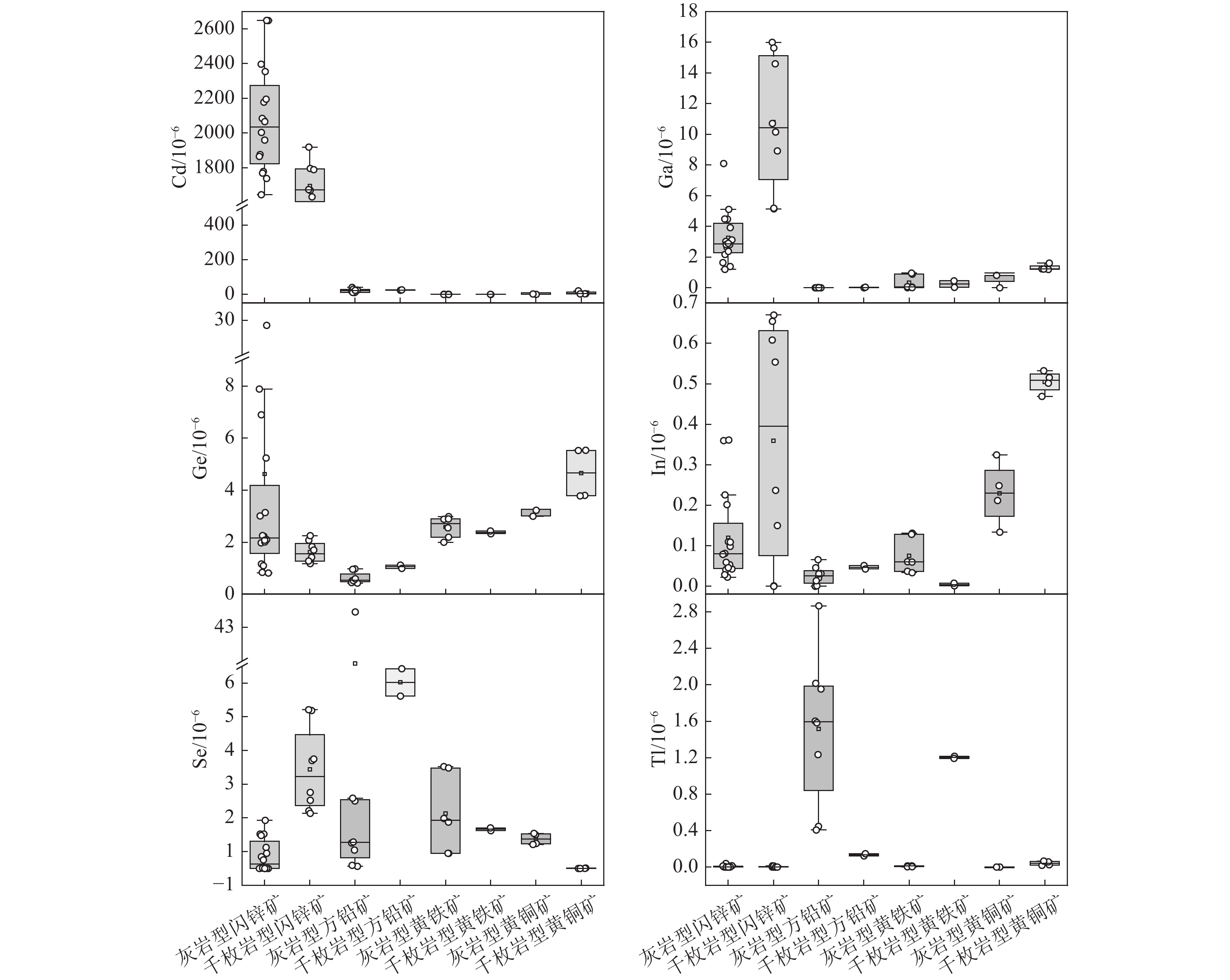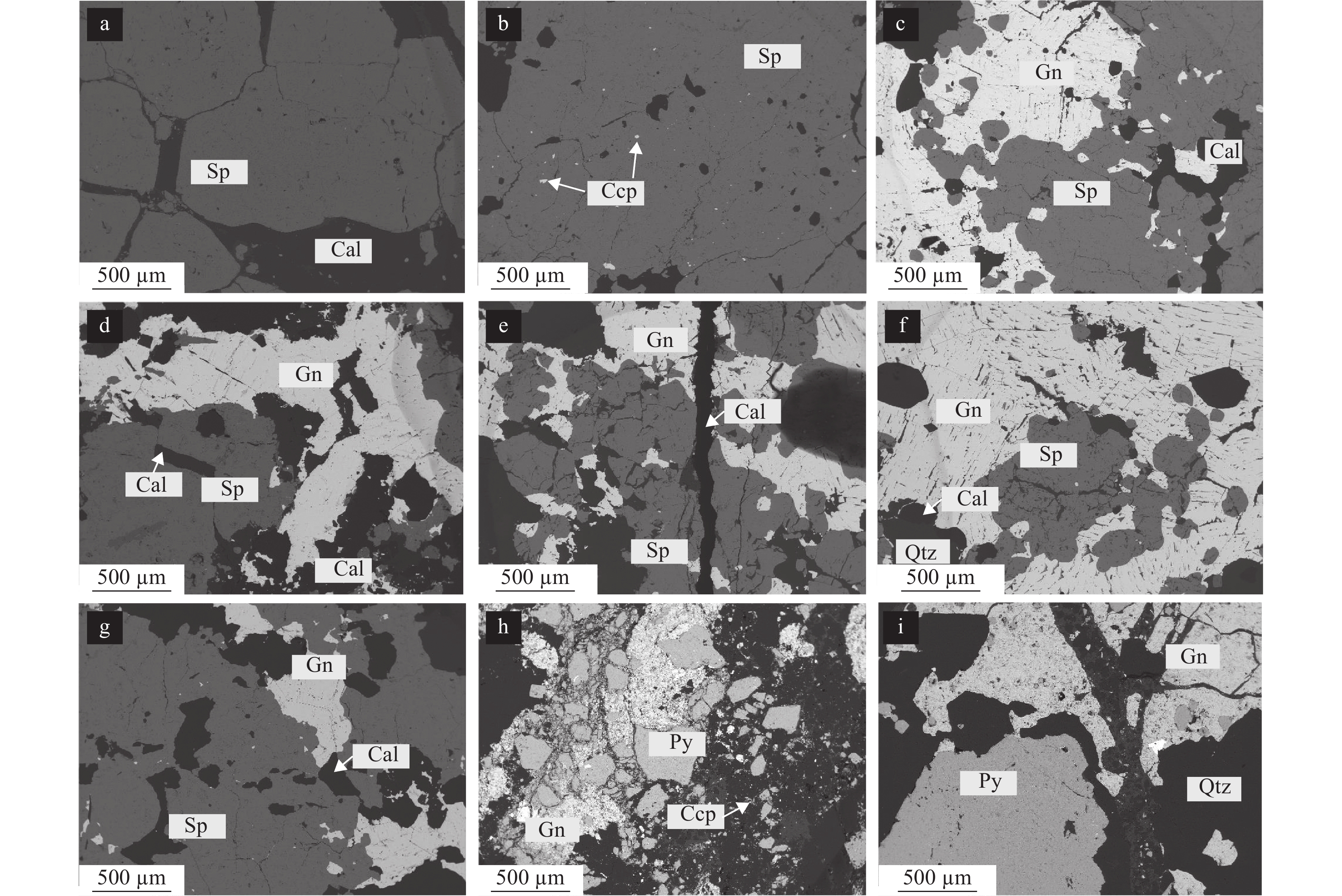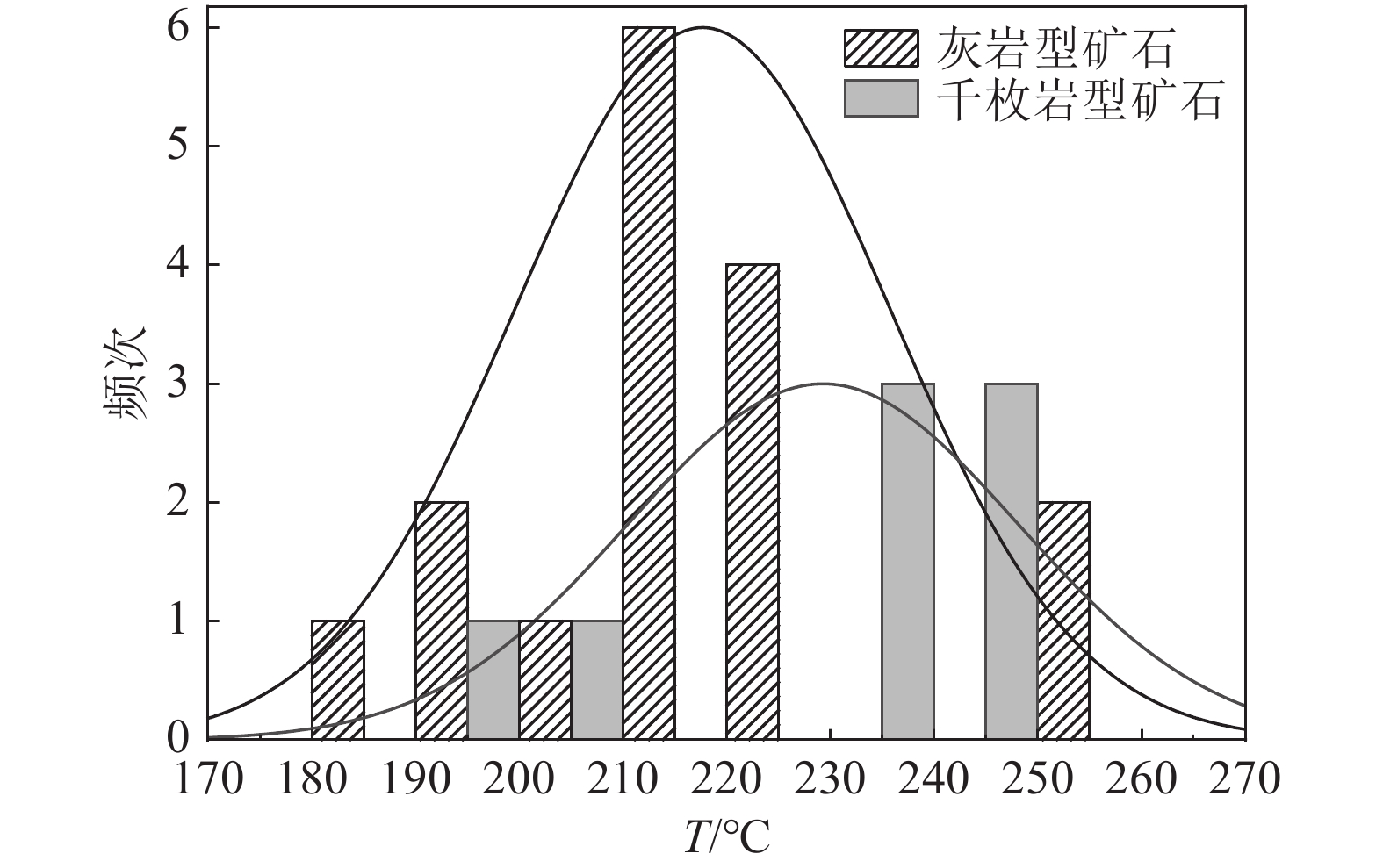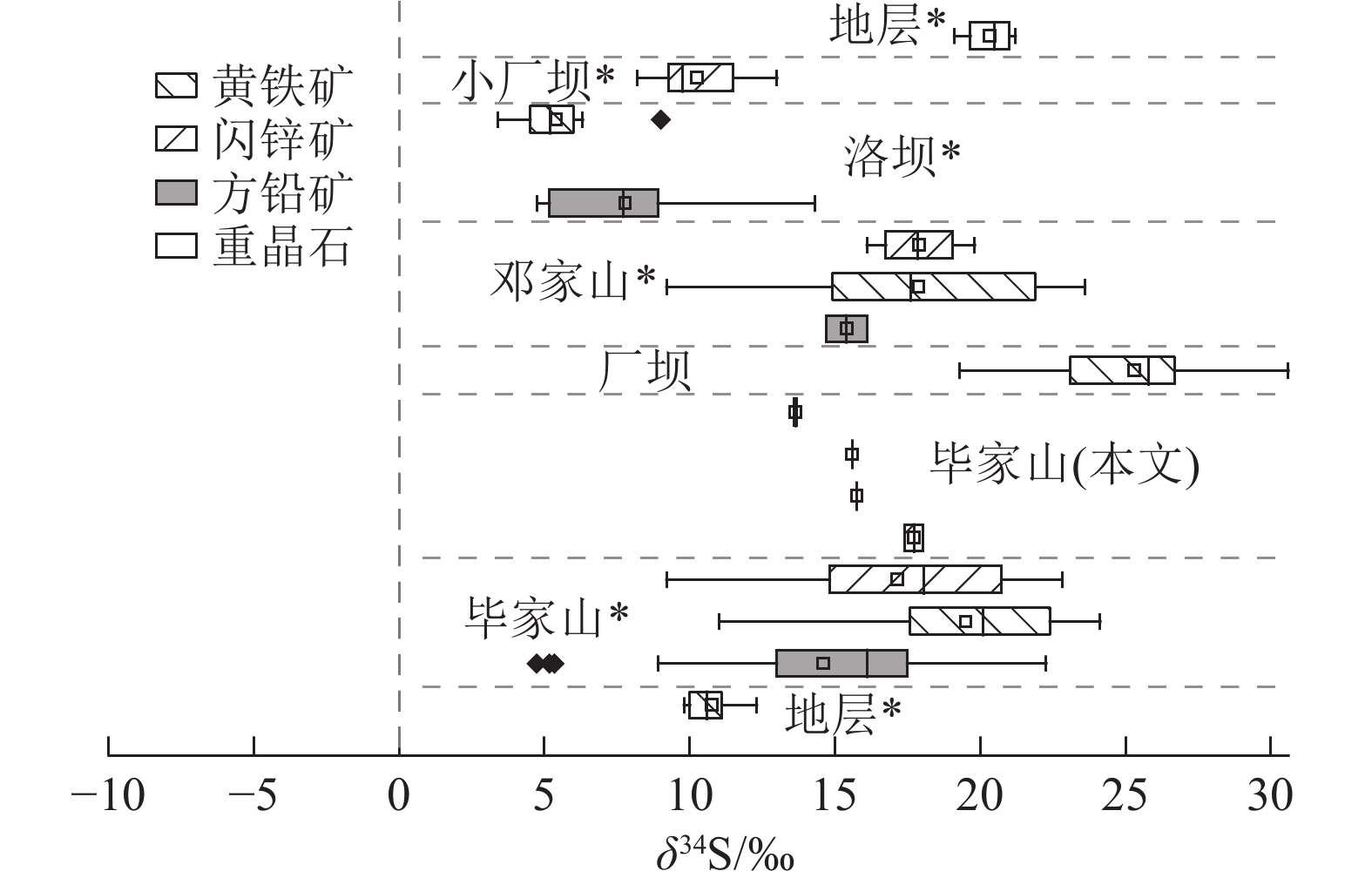Occurrence of cadmium and ore genesis in the Bijiashan lead-zinc deposit: Evidence from LA−ICP−MS trace elements and in-situ sulfur isotope of sulfide
-
摘要:
甘肃毕家山铅锌矿床是西秦岭造山带西成矿田发现的首个铅锌矿床,累计探明铅锌资源量120×104t,Pb和Zn的品位分别为1.86%和5.42%。矿床中发育2类矿体,分别是赋存于灰岩中的灰岩型和赋存于千枚岩中的千枚岩型。2类矿体的矿石矿物组合均为闪锌矿+方铅矿±黄铁矿±黄铜矿。毕家山铅锌矿床镉的赋存状态尚不明确。通过激光剥蚀电感耦合等离子质谱仪(LA−ICP−MS)分别对灰岩型和千枚岩型矿石中的硫化物(闪锌矿、方铅矿、黄铁矿和黄铜矿)进行了微量元素及原位S同位素分析。研究结果显示,灰岩型和千枚岩型矿石中闪锌矿的Cd平均含量分别为2076×10−6和1695×10−6,高于矿产工业一般标准(1000×10−6),而方铅矿、黄铁矿和黄铜矿中的Ga、Ge、Se、In、Tl含量均低于矿产工业一般标准(100×10−6)。结合岩相学和LA−ICP−MS分析发现,毕家山铅锌矿床无Cd的独立矿物和以吸附形式存在的Cd,Cd主要以Cd2+↔Zn2+类质同象形式赋存于闪锌矿中,其次为Cd2+ +Fe2+ ↔ 2Zn2+。通过闪锌矿微量元素温度计获得灰岩型和千枚岩型矿石中闪锌矿的形成温度分别为198~254℃(平均值为227℃)和203~245℃(平均值为230℃),与前人通过流体包裹体和矿物对温度计的研究结果一致,表明其成矿温度为中温。此外,原位硫同位素分析结果显示,该矿床中灰岩型和千枚岩型矿石的δ34S平均值分别为+13.64‰和+17.72‰,表明硫来源于海相硫酸盐。综合闪锌矿微量元素数据、同位素地球化学、成矿温度、岩相古地理和矿床地质特征对比分析,推测毕家山铅锌矿床的成因类型属于SEDEX型。
Abstract:The Bijiashan deposit is the first lead−zinc deposit discovered in the Xicheng ore field in the West Qinling Orogenic Belt (WQOB), with reserves of 1.2 million tons of lead and zinc, and grades of 1.86% and 5.42%, respectively. This deposit is characterised by the presence of two distinct types of orebodies: limestone−type and phyllite−type, which are located within limestone and phyllite formations, respectively. The mineral assemblages present in both ore types include sphalerite, galena, pyrite, and chalcopyrite. Previous investigations have primarily concentrated on the geological characteristics, petrography, isotope geochemistry, and fluid inclusions associated with the deposit; however, the occurrence of cadmium (Cd) is still uncertain. In this study, laser ablation inductively coupled plasma mass spectrometry (LA−ICP−MS) was employed to analyse various sulfide minerals (sphalerite, galena, pyrite, and chalcopyrite) from both ore types. The analytical results indicate that the average Cd content in sphalerite from the limestone−type and phyllite−type ores is 2076×10−6 and 1695×10−6, respectively, exceeding the general industry standard of 1000×10−6. Conversely, the concentrations of gallium (Ga), germanium (Ge), selenium (Se), indium (In), and thallium (Tl) in galena, pyrite, and chalcopyrite from both ore types are below the mineral industry standard of 100×10−6. Based on petrographic observations and LA−ICP−MS analyses, it is proposed that there are no independent Cd minerals present in the Bijiashan lead−zinc deposit. Instead, Cd is primarily incorporated into sphalerite through the substitution mechanism of Cd2+ ↔ Zn2+, with a minor substitution pathway of Cd2+ + Fe2+ ↔ 2Zn2+. The estimated formation temperature for sphalerite in the limestone type and phyllite type ores are 198–254°C (mean of 227°C) and 203–245°C (mean of 230°C), respectively. These findings are consistent with previous studies utilising fluid inclusion thermometry, suggesting a moderate temperature for ore−forming mineralisation. In−situ sulfur isotope analysis reveals average δ34S values of 13.64‰ and 17.72‰ for the respective ore types, indicating a marine sulfate source. Drawing upon the evidence from LA−ICP−MS trace element data of sphalerite, petrography, geological characteristics of the deposit, isotope geochemistry, and metallogenic temperature, we propose that the Bijiashan lead−zinc deposit is classified as a sedimentary−exhalative (SEDEX) deposit.
-
Keywords:
- Bijiashan lead-zinc deposit /
- cadmium /
- occurrence /
- LA−ICP−MS /
- sulfur isotope /
- Xicheng ore field /
- ore genesis
-
油页岩属于非常规油气资源,利用蒸馏等技术处理后能够获得页岩气及页岩油,是一种前景非常好的油气资源,被列为21世纪非常重要的接替能源(侯祥麟,1994;赵政璋等,2005;刘招君等,2006;王红岩等,2009)。中国油页岩资源丰富,资源潜力大,其中松辽盆地是油页岩资源极丰富的地区,占东北地区油页岩资源总量的96%(刘招君等,2009)。松辽盆地是一个大型陆相薄互层沉积盆地,岩石物性横向变化大,地层平缓且构造幅度小,油页岩单层厚度薄,这种复杂的沉积结构增加了地震勘探的难度(李桂林,2009)。大地电磁法由于天然场源的随机性及信号微弱精度和效率较低,电阻率法则存在探测深度浅、高阻层屏蔽等缺点。测井技术在识别和评价油页岩方面较成熟(丰莉等,2016;刘同庆,2020),已被广泛应用于油页岩矿区,但是由于其空间探测范围的局限性,存在横向范围内描述储层物性变化能力很弱的缺陷。
测井具有较高的纵向地层分辨率,将测井数据作为先验信息进行电磁法约束反演,可以提高反演结果的纵向分辨率。朱宇启等(2021)在南黄海中部隆起区对海洋CSEM实测数据进行测井约束反演,突出了垂向发生明显变化的层位。Brown et al.(2012)发现,利用测井数据进行正则化约束反演比常规反演结果更紧凑地估计了储层结构。余年等(2012)利用测井数据作为先验信息开展大地电磁约束反演,与常规反演结果相比,约束反演结果对岩溶、断层、褶皱等地质构造的反映与实际吻合更好。自20世纪80年代以来,可控源音频大地电磁法和仪器都得到了很大发展,具有设备轻便、勘探深度相对较大、不受高阻层屏蔽、横向分辨率高等特点(何梅兴,2006;余年等,2012),在勘探石油、天然气、金属矿床、地热等领域得到广泛应用(秦伟,2013;李致君等,2018;李英宾等,2019)。地球物理方法和测井技术在联合研究油页岩储层特征方面几乎还是空白,本文通过松辽盆地采集的可控源音频大地电磁数据,利用测井资料作为先验信息,开展可控源音频大地电磁法和测井联合约束反演技术应用研究,将油页岩与泥页岩互层整体作为相对高阻层,进行划分识别,取得较好的效果,初步查明研究区油页岩的展布特征,为进一步勘探工作指明了有利方向。
1. 地质地球物理背景
1.1 地质条件
研究区位于松辽盆地东南隆起区(图1)。松辽盆地形成于印支运动末期—燕山运动早期,经历了多期构造运动,盆地内部划分出西部斜坡区、北部倾没区、东北隆起区、中央坳陷区、东南隆起区和西南隆起区6个一级构造单元(张利,2020)。
东南隆起区位于盆地边部,自西向东分为次一级背斜、向斜构造,主要有登娄库背斜、哈拉海向斜、农安背斜、德惠向斜、青山口背斜、杨大城子背斜;主要发育中、新生代地层,自下而上依次为白垩系火石岭组、沙河子组、营城组、登娄库组、泉头组、青山口组、姚家组、嫩江组,新近系大安组及第四系(高立新,2008;李宝毅等,2012;李翔等,2014),油页岩主要存在于白垩系青山口组一段和嫩江组一段、二段,油页岩矿层单层厚度较薄,与沉积岩地层呈互层关系。
1.2 地层电性特征
根据研究区及周缘物性资料分析,第四系为表层高阻层,古近系—新近系大安组−青山口组为低阻层,泉头组−登楼库组为中阻层,营城组−火石岭层为次高阻层,局部发育火山岩为高阻,石炭系—二叠系为基底高阻层(表1)。地层电性特征分析表明,白垩系嫩江组、青山口组电阻率整体呈现低阻特征。
表 1 研究区及周缘地区岩层电性特征Table 1. The electrical characteristics of rock strata in the study area and surrounding areas系 统 组 符号 岩性特征 ρ/(Ω·m) 电性 第四系 Q 粘土、亚粘土、砂砾石 37.9 表层高阻 古近系—新近系 大安组 Nd 泥岩、粉砂质泥岩、泥质粉砂岩 3.2 低阻层 白垩系 上统 嫩江组 K2n 砂砾岩、粉砂岩、细砂岩、泥质粉砂岩、粉砂质泥岩、泥岩、油页岩 3.9 姚家组 K2y 泥岩、粉砂质泥岩、泥质粉砂岩、粉砂岩 6.8 青山口组 K2qs 质粉砂岩、粉砂岩、粉砂质泥岩、油页岩 22.8 下统 泉头组 K1q 粉砂质泥岩、泥岩、粉砂岩、泥质粉砂岩、细砂岩、砂岩 28.2 中阻层 登楼库组 K1d 砂砾岩夹泥岩 71.5 营城组 K1yc 泥岩与火山岩间互夹煤层 211.7 次高阻层 沙河子组 K1sh 火山岩、砂泥岩夹煤线 220.0 火石岭组 K1h 火山碎屑岩、火山喷发岩 240.0 石炭系—二叠系 293.0 基底高阻 1.3 油页岩物性特征
油页岩含丰富的有机质,有机质具有低密度、高电阻率特征,在含油页岩的沉积地层中,油页岩层与围岩存在电阻率、密度等物性差异(Constable et al.,1987;贺君玲等,2006;王永明等,2007)。
综合分析研究区不同测井曲线发现,油页岩呈现中高电阻率、高自然伽马、高声波时差和低密度特征;泥岩呈现低电阻率、高自然伽马、高声波时差和高密度特征;粉砂岩具有中高电阻率、低自然伽马、低声波时差、低密度特征;粉砂质泥岩相对于泥岩电阻率偏高、自然伽马偏低、声波时差偏低、密度偏低;泥质粉砂岩相对于粉砂岩电阻率偏低、自然伽马偏高、声波时差偏高、密度高。油页岩与粉砂岩、粉砂质泥岩及泥质粉砂岩在电阻率和密度方面均呈现高电阻率、低密度特征,但与围岩泥岩存在明显的电阻率和密度差异(表2;图2),油页岩有机质含量越高,这种特征越明显。因此,根据不同测井曲线形态和曲线值可以判断出不同岩性,划分识别油页岩。
表 2 研究区白垩系不同岩性测井曲线响应分布范围Table 2. Logging response distribution range table of Cretaceous different lithology in the study area测井识别岩性 电阻率平均值/(Ω·m) 声波时差平均值/(μs·m−1) 补偿密度平均值/(g·cm−3) 自然伽马平均值/API 粉砂岩 10 ~ 13 250 ~ 430 2.15 ~ 2.62 50 ~ 115 泥质粉砂岩 6.5 ~ 17.5 240 ~ 450 2.20 ~ 2.50 75 ~ 140 粉砂质泥岩 5.5 ~ 12 275 ~ 500 2.25 ~ 2.55 90 ~ 135 泥岩 5 ~ 9 330 ~ 450 2.25 ~ 2.50 110 ~ 150 油页岩 7.5 ~ 15 ≥375 ≤2.35 ≥130 2. 勘探方法
2.1 方法原理
CSAMT法全称是可控源音频大地电磁测深法,属于人工源频率域电磁测深法,以有限长接地电偶极子为场源,其核心是采用大小随着频率改变的音频电流来建立人工电磁场,激发地下空间产生电磁感应,当电磁场变为谐变场时通过改变电磁场的频率来达到测深目的,采集电磁场参数,求取视电阻率、阻抗相位等电磁响应数据,具有工作效率高、勘探深度范围大、水平方向分辨能力高、地形影响小、高阻层的屏蔽作用小等特点。
2.2 数据采集与处理
研究区CSAMT测线均过钻井(图1),测线总长80 km,点距100 m,采用美国Zonge公司生产的GDP-3224多功能电法仪,发电输出功率30 kW。数据采用赤道偶极装置进行标量测量,发射偶极AB与测线平行布设,长度为1 ~ 2 km,接收偶极100 m,发射源接地电阻要求20 ~ 40 Ω,接收端接地电阻不大于2000 Ω;同时观测与场源平行的电场水平分量Ex和与场源正交的磁场水平分量Hy,采集频率范围为 0.125 ~ 8192 Hz。
数据处理采用人机交互的方式进行,包括去噪、静态校正、近场校正、视电阻率、相位拟断面分析等。近场校正采用过渡三角形法,消除卡尼亚电阻率在近区由于非平面波效应产生的畸变,采用空间滤波、中值滤波、曲线平移等方法进行静态位移综合校正。图3为SL-01线视电阻率和阻抗相位断面图,视电阻率、阻抗相位等值线连续光滑,噪声、近场效应及静位移影响得到较好的压制,断面图上电性层由高频到低频呈现高、低、次低、高的变化特征。
2.3 约束反演技术
常规二维正则化OCCAM反演方法是一种由电磁测深数据产生光滑模型的实用算法,体现了正则化反演优点,在保证电性分布连续或光滑的条件下,寻求有极小可能构造意义下拟合数据的模型(Constable et al.,1987),该方法收敛稳定,对初始模型依赖度低,成像效果好,被广泛应用于电磁数据处理中。研究区存在人文干扰,受干扰的数据不能真实反映地下电性结构,对地质解释的可靠性存在影响,同时可控源音频大地电磁反演存在多解性、非唯一性的问题,为此在二维正则化OCCAM反演的基础上,将研究区测井信息融入到可控源音频大地电磁资料的反演处理中,减少反演结果的非唯一性,提高成果解释的精度和合理性(孟翠贤,2003;张凯飞,2016)。二维OCCAM地电约束反演主要包括地电模型建立、反演算法与正则化因子、模型粗糙度及迭代误差分析。
(1)地电模型建立
对研究区可控源音频大地电磁测线周边测井资料进行处理分析,根据不同物性特征对钻孔处地层进行划分,重点对嫩江组和青山口组油页岩及附近地层进行划分,建立可控源音频大地电磁资料处理所需要的电阻率分布先验地电模型,数据反演过程中加入先验地电信息开展约束反演。表3、表4为SL-03线先验约束信息。
表 3 吉扶地3井油页岩及附近地层约束信息Table 3. Constraint information of oil shale and nearby strata in Well Jifudi 3序号 顶部深度/m 底部深度/m 厚度/m 电阻率/(Ω·m) 岩性 序号 顶部深度/m 底部深度/m 厚度/m 电阻率/(Ω·m) 岩性 1 258.2 268.6 10.4 9.19 泥岩 15 469.8 476.9 7.1 6.23 泥岩 2 268.6 281.4 12.8 10.70 粉砂质泥岩 16 476.9 478.0 1.1 6.99 油页岩 3 281.4 289.0 7.6 9.55 泥岩 17 478.0 483.2 5.2 5.70 泥岩 4 289.0 294.1 5.1 12.90 粉砂质泥岩 18 483.2 484.1 0.9 6.27 油页岩 5 294.1 298.3 4.2 9.44 泥岩 19 484.1 487.3 3.2 6.22 泥岩 6 298.3 306.6 8.3 11.61 粉砂质泥岩 20 487.3 489.5 2.2 8.38 粉砂质泥岩 7 306.6 312.4 5.8 9.55 泥岩 21 489.5 494.2 4.7 6.06 油页岩 8 312.4 341.0 28.6 10.92 粉砂质泥岩 22 494.2 503.2 9.0 5.25 泥岩 9 341.0 382.3 41.3 6.49 泥岩 23 503.2 507.1 3.9 12.73 油页岩 10 382.3 383.2 0.9 6.45 油页岩 24 507.1 514.0 6.9 7.19 泥岩 11 383.2 462.2 79.0 5.95 泥岩 25 514.0 519.3 5.3 11.22 油页岩 12 462.2 463.4 1.2 7.19 油页岩 26 519.3 523.1 3.8 5.91 泥岩 13 463.4 468.0 4.6 6.10 泥岩 27 523.1 524.0 0.9 10.72 油页岩 14 468.0 469.8 1.8 7.65 油页岩 28 524.0 528.7 4.7 8.34 粉砂质泥岩 表 4 吉扶地8井油页岩及附近地层约束信息Table 4. Constraint information of oil shale and nearby strata in Well Jifudi 8序号 顶部深度/m 底部深度/m 厚度/m 电阻率/(Ω·m) 岩性 序号 顶部深度/m 底部深度/m 厚度/m 电阻率/(Ω·m) 岩性 1 258.2 268.6 10.4 9.19 泥岩 15 469.8 476.9 7.1 6.23 泥岩 2 268.6 281.4 12.8 10.70 粉砂质泥岩 16 476.9 478.0 1.1 6.99 油页岩 3 281.4 289.0 7.6 9.55 泥岩 17 478.0 483.2 5.2 5.70 泥岩 4 289.0 294.1 5.1 12.90 粉砂质泥岩 18 483.2 484.1 0.9 6.27 油页岩 5 294.1 298.3 4.2 9.44 泥岩 19 484.1 487.3 3.2 6.22 泥岩 6 298.3 306.6 8.3 11.61 粉砂质泥岩 20 487.3 489.5 2.2 8.38 粉砂质泥岩 7 306.6 312.4 5.8 9.55 泥岩 21 489.5 494.2 4.7 6.06 油页岩 8 312.4 341.0 28.6 10.92 粉砂质泥岩 22 494.2 503.2 9.0 5.25 泥岩 9 341.0 382.3 41.3 6.49 泥岩 23 503.2 507.1 3.9 12.73 油页岩 10 382.3 383.2 0.9 6.45 油页岩 24 507.1 514.0 6.9 7.19 泥岩 11 383.2 462.2 79.0 5.95 泥岩 25 514.0 519.3 5.3 11.22 油页岩 12 462.2 463.4 1.2 7.19 油页岩 26 519.3 523.1 3.8 5.91 泥岩 13 463.4 468.0 4.6 6.10 泥岩 27 523.1 524.0 0.9 10.72 油页岩 14 468.0 469.8 1.8 7.65 油页岩 28 524.0 528.7 4.7 8.34 粉砂质泥岩 (2)反演算法
二维Occam地电约束反演重点是对目标函数中的模型粗糙度进行修改,推导出修改后目标函数的迭代格式,形成以地电参数作为先验信息的约束反演算法。反演过程中在目标函数中加入利用测井等资料建立的先验地电模型,在已知电性分布区域修正模型,不断地向先验地电模型靠拢,提高反演结果与实测数据的拟合度。具体流程如下:
① 建立可控源音频大地电磁反演目标函数,在目标函数模型粗糙度中加入模型约束项。
U=‖ (1) 式中, {\left\|{\partial }_{y}m\right\|}^{2}+{\left\|{\partial }_{z}m\right\|}^{2} 为模型粗糙度,μ为拉格朗日乘子,即正则化因子, W 为归一化计算后 M\times M 的对角加权矩阵, F(m) 模型为 m 在一定的激发作用下正演后取得的响应,X*2为反演拟合差。
② 根据已知钻孔及测井数据建立初始模型,构造二维粗糙度矩阵:
{R}_{1}=\alpha {\left\|C(m-{m}_{0})\right\|}^{2}+{\left\|{\partial }_{y}m\right\|}^{2}+{\left\|{\partial }_{z}m\right\|}^{2} (2) 式中, \alpha {\left\|C(m-{m}_{0})\right\|}^{2} 为先验模型的约束项, \alpha 为权重系数, {m}_{0} 为先验模型, m 为迭代过程中当前模型, C 为约束矩阵。
③ 根据约束后的目标函数,计算推导迭代格式,开展反演迭代计算。
\begin{split} &{m}_{k+1}\left(\mu \right)={\left[\alpha \mu {C}^{T}+\mu \left({\partial }_{x}^{T}{\partial }_{x}+{\partial }_{z}^{T}{\partial }_{z}\right)+ {\left(W{J}_{k}\right)}^{T}W{J}_{k}\right]}^{-1}.\\ &\qquad \left[{\left(W{J}_{k}\right)}^{T}W{d}_{k}+\alpha \mu {C}^{T}C{m}_{0}\right]\\[-1pt]\end{split} (3) 式中 ,{J}_{k} 为雅可比矩阵, {d}_{k}=d-F\left[{m}_{k}\right]+{J}_{k}{m}_{k} ,拉格朗日乘子μ为待求值。
④ 求取模型 {m}_{k+1}\left(\mu \right) 的一系列μ值,根据 \mu 值计算模型 {m}_{k+1}\left(\mu \right) 拟合差,选取数据残差平方最小的 \mu 值。
(3)正则化因子、模型粗糙度及迭代误差分析
本次约束反演正则化因子初始值为1000,模型粗糙度随正则化因子增大呈现波动变化,当正则化因子增大到一定值时,逐步变小,最后趋于稳定(图4)。经过15次迭代计算,二维地电约束反演结果趋近稳定,图5为SL-01线约束前后迭代反演曲线误差对比图,拟合差分别为0.77和0.78,拟合初期约束反演拟合误差比常规反演拟合误差大,拟合后期常规反演提前趋于稳定。
3. 效果分析
(1)常规二维OCCAM反演能够反映出规模较大的异常体,但是对于规模较小的异常体分辨能力不足,由SL-01线二维OCCAM反演与二维OCCAM约束反演剖面对比图(图6)可以看出,二维OCCAM地电约束反演剖面纵向上地层电性变化特征清楚,横向分辨率也有很大的提高,能够明显提高对异常体的分辨率,地电信息更丰富,较好地反映了研究区地层平缓、构造幅度小、岩石物性横向变化大的地质特征,油页岩与泥岩作为整体得到较好反映。
(2)以二维OCCAM地电约束反演剖面为主,结合测井、以往物探地质资料进行综合解释,可以对油页岩与泥页整体进行有效识别。图7为SL-01线二维地电约束反演及地质解释剖面,二维地电约束反演剖面纵向上呈现高—低—中—次高—高变化特征,电性结构变化与电测井曲线吻合较好。表层高阻层反映了第四系沉积地层分布与厚度变化特征,电阻率值为15 ~ 55 Ω·m,厚度10 ~ 50 m;中浅部低阻层主要反映了白垩系嫩江组、姚家组及青山口组的分布,电阻率值为3 ~ 12 Ω·m,厚度180 ~ 750 m,局部存在相对高阻异常,与电测井曲线上粉砂质泥岩、泥质粉砂岩、粉砂岩、油页岩和泥岩互层基本对应;下部中阻层代表白垩系泉头组,电阻率值为6 ~ 17 Ω·m,厚度50 ~ 100 m;下部次高阻层代表白垩系火石岭组—登楼库组,电阻率值为7 ~ 22 Ω·m,厚度400 ~ 1000 m;底部分布的高阻层代表了变质岩或侵入体基底,顶面最大埋深范围大于1000 m。利用电测井曲线及分层数据,结合约束反演剖面电阻率变化特征,将中浅部低阻层进一步划分为嫩江组、姚家组和青山口组,在嫩江组、青山口组划分的基础上,油页岩与泥岩整体作为相对高阻层可划分识别。
(3)通过研究区采集的可控源音频电磁测线地电约束反演及综合解释,对研究区地层、构造及油页岩矿层展布特征获得了整体认识:① 研究区横跨登楼库背斜和哈拉海向斜2个构造,背斜核部地层以白垩系泉头组、青山口组为主,翼部为姚家组、嫩江组,向斜核部地层以白垩系嫩江组为主,翼部为姚家组、青山口组。以登楼库背斜轴为界,两翼地层倾角均为1° ~ 6°,核部近水平,呈宽缓的背斜构造,整体控制白垩系的分布,影响油页岩矿层的空间展布。②登楼库背斜地层较哈拉海向斜整体抬升,导致研究区背斜所在区域的嫩江组基本缺失,嫩江组油页岩主要分布在哈拉海向斜,仅在背斜西部局部沉积,油页岩与泥岩互层厚度为25 ~ 100 m,埋深50 ~ 250 m。青山口组油页岩分布范围广,登楼库背斜、哈拉海向斜均有分布,油页岩与泥岩互层厚度为30 ~ 200 m,埋深400 ~ 800 m,整体呈沿登楼库背斜轴高、沿背斜轴两翼逐渐减薄的特征。
4. 结 论
(1)可控源音频大地电磁和测井联合约束反演技术能够提高对异常体的分辨率,油页岩与泥岩互层作为整体只要具有一定的规模,利用可控源音频大地电磁和测井联合约束反演技术就可以划分识别。
(2)油页岩单层厚度薄,单一地球物理方法划分识别油页岩存在很大的局限性,基于测井综合曲线分析技术的地球物理方法是油页岩勘探方法发展的方向。
(3)油页岩与砂岩、粉砂岩和粉砂质泥岩均呈现相对高电阻率特征,区分困难,可以开展可控源音频电磁法、时频电磁法等多种方法试验,利用电阻率、极化率等多参数综合分析研究。
-
图 1 西成矿田地质图(据王集磊等,1996修改)
Figure 1. Geological map of Xicheng ore field
图 2 毕家山矿区地质图(据王集磊等,1996修改)
Figure 2. Geological map of the Bijiashan lead-zinc deposit
图 3 毕家山铅锌矿床14号勘探线地质剖面(据王集磊等,1996修改)
Figure 3. Geological profile of exploration line No.14 from the Bijiashan lead-zinc deposit
表 1 毕家山铅锌矿床中闪锌矿、方铅矿、黄铁矿和黄铜矿电子探针成分含量分析结果
Table 1 The analytical results of sphalerite, galena, pyrite and chalcopyrite from the Bijiashan Pb−Zn deposit using electron probe
% 类型 矿物 点号 Zn S Pb Fe Cu Cd Ga Ge Tl Cr Se In Te 总和 灰岩型矿石 闪锌矿 4-1 65.6 32.2 <Bdl 1.13 <Bdl 0.21 0.06 <Bdl <Bdl <Bdl <Bdl 0.03 0.03 98.2 4-2 65.6 32.3 <Bdl 1.15 <Bdl 0.22 <Bdl <Bdl <Bdl <Bdl <Bdl 0.03 0.02 99.4 5-1 65.7 32.8 <Bdl 1.97 <Bdl 0.25 <Bdl 0.02 <Bdl 0.01 <Bdl <Bdl <Bdl 100.7 5-2 64.2 32.5 <Bdl 3.77 <Bdl 0.21 <Bdl <Bdl <Bdl <Bdl <Bdl <Bdl 0.01 100.7 6-1 65.7 32.1 <Bdl 1.20 <Bdl 0.17 <Bdl 0.04 <Bdl 0.02 <Bdl <Bdl <Bdl 99.3 6-2 63.9 32.3 <Bdl 2.81 <Bdl 0.17 0.03 <Bdl <Bdl <Bdl 0.01 <Bdl <Bdl 99.3 12-1 64.5 32.6 0.02 4.75 <Bdl 0.24 <Bdl <Bdl <Bdl 0.02 0.01 0.02 0.04 102.2 12-2 65.0 32.4 0.04 5.33 0.01 0.18 0.03 0.02 <Bdl 0.01 <Bdl 0.02 0.01 103.0 14-1 65.7 32.2 0.01 1.75 <Bdl 0.28 <Bdl <Bdl <Bdl 0.01 <Bdl <Bdl 0.02 100.0 14-2 66.3 32.1 <Bdl 1.26 <Bdl 0.24 <Bdl <Bdl <Bdl 0.01 <Bdl <Bdl 0.03 100.0 16-1 65.4 32.3 <Bdl 2.62 0.02 0.19 <Bdl <Bdl <Bdl 0.01 <Bdl 0.01 0.01 100.5 16-2 65.4 32.3 <Bdl 2.63 0.02 0.18 <Bdl <Bdl <Bdl 0.01 <Bdl 0.01 0.01 100.5 21-1 66.4 32.3 <Bdl 1.41 <Bdl 0.30 0.10 <Bdl 0.01 <Bdl <Bdl <Bdl 0.04 100.5 21-2 64.9 32.4 <Bdl 2.82 0.03 0.25 0.04 <Bdl <Bdl <Bdl <Bdl <Bdl <Bdl 100.5 23-1 66.3 32.5 <Bdl 1.79 <Bdl 0.19 0.10 <Bdl <Bdl <Bdl <Bdl <Bdl 0.01 100.8 23-2 65.8 32.4 <Bdl 3.21 0.02 0.22 <Bdl 0.02 <Bdl <Bdl <Bdl <Bdl 0.01 101.7 千枚岩型矿石 闪锌矿 25-1 63.0 32.5 <Bdl 3.90 <Bdl 0.17 <Bdl <Bdl <Bdl 0.01 <Bdl <Bdl 0.01 99.6 25-2 62.9 32.5 <Bdl 3.86 <Bdl 0.17 <Bdl <Bdl <Bdl 0.01 <Bdl <Bdl 0.01 99.4 28-1 63.5 32.4 <Bdl 5.83 0.01 0.20 0.07 <Bdl <Bdl <Bdl <Bdl 0.02 0.01 102.1 28-2 62.0 32.5 <Bdl 5.76 0.01 0.21 0.06 <Bdl <Bdl <Bdl <Bdl 0.02 0.01 100.5 30-1 62.0 32.7 <Bdl 6.94 0.02 0.22 <Bdl <Bdl <Bdl <Bdl <Bdl <Bdl 0.01 101.9 30-2 62.4 32.5 0.04 4.41 0.32 0.25 <Bdl <Bdl <Bdl 0.01 <Bdl <Bdl 0.02 100.0 31-1 62.4 32.7 <Bdl 4.58 <Bdl 0.18 0.02 <Bdl <Bdl <Bdl <Bdl <Bdl 0.04 99.9 31-2 62.4 32.5 <Bdl 4.57 <Bdl 0.19 0.02 <Bdl <Bdl <Bdl <Bdl <Bdl 0.04 99.7 灰岩型矿石 方铅矿 5-1 0.08 13.4 85.5 <Bdl <Bdl 0.13 <Bdl 0.07 <Bdl <Bdl <Bdl <Bdl 0.04 99.2 8-1 0.11 13.2 84.7 0.02 <Bdl 0.18 <Bdl 0.01 <Bdl <Bdl <Bdl <Bdl 0.12 98.3 9-1 0.08 13.2 85.4 0.02 0.01 0.11 <Bdl 0.02 <Bdl <Bdl <Bdl <Bdl 0.08 98.9 12-1 0.11 13.2 85.6 <Bdl 0.04 0.11 <Bdl 0.03 <Bdl 0.06 <Bdl <Bdl 0.05 99.2 12-2 0.04 13.2 84.7 <Bdl <Bdl 0.17 0.01 <Bdl <Bdl <Bdl <Bdl <Bdl 0.06 98.2 14-1 0.06 13.5 85.4 0.01 <Bdl 0.12 <Bdl <Bdl <Bdl <Bdl <Bdl <Bdl 0.05 99.1 14-2 0.07 13.5 85.4 0.01 <Bdl 0.13 <Bdl <Bdl <Bdl <Bdl <Bdl <Bdl 0.05 99.1 千枚岩型矿石 方铅矿 22-1 0.10 13.0 84.8 0.02 <Bdl 0.19 <Bdl 0.03 <Bdl <Bdl <Bdl <Bdl 0.12 98.2 27-1 0.08 13.0 84.9 0.01 <Bdl 0.14 <Bdl 0.05 <Bdl <Bdl <Bdl <Bdl 0.03 98.3 27-2 0.07 13.0 85.0 0.01 <Bdl 0.14 <Bdl 0.05 <Bdl <Bdl <Bdl <Bdl 0.25 98.5 灰岩型矿石 黄铁矿 4-1 0.09 53.0 <Bdl 46.5 <Bdl 0.01 <Bdl <Bdl <Bdl <Bdl <Bdl <Bdl 0.02 99.6 4-2 0.08 53.1 <Bdl 46.5 <Bdl 0.01 <Bdl <Bdl <Bdl <Bdl <Bdl <Bdl 0.02 99.7 10-1 0.01 52.8 0.01 46.3 <Bdl 0.01 <Bdl <Bdl <Bdl 0.01 <Bdl <Bdl 0.05 99.2 13-1 0.03 53.0 <Bdl 43.5 4.25 0.02 <Bdl <Bdl <Bdl <Bdl <Bdl <Bdl 0.02 100.9 13-2 0.02 53.0 <Bdl 43.5 <Bdl 0.02 <Bdl <Bdl <Bdl <Bdl <Bdl <Bdl 0.02 96.6 13-3 0.04 53.3 <Bdl 46.5 0.17 0.04 <Bdl <Bdl <Bdl <Bdl <Bdl <Bdl <Bdl 100.1 千枚岩型矿石 黄铁矿 30-1 0.01 51.9 0.01 48.8 0.07 0.02 <Bdl <Bdl <Bdl 0.01 <Bdl <Bdl <Bdl 100.8 30-2 0.01 53.0 0.01 48.7 0.07 0.02 <Bdl <Bdl <Bdl 0.01 <Bdl <Bdl <Bdl 101.8 灰岩型矿石 黄铜矿 13-1 0.09 34.8 0.01 30.9 34.5 0.04 <Bdl <Bdl <Bdl 0.03 0.01 <Bdl 0.03 100.5 13-2 2.47 34.6 0.04 30.0 33.3 0.05 <Bdl <Bdl <Bdl 0.04 <Bdl <Bdl <Bdl 100.4 千枚岩型矿石 黄铜矿 27-1 0.01 34.9 0.06 30.8 34.5 0.03 <Bdl <Bdl <Bdl <Bdl <Bdl <Bdl <Bdl 100.4 27-2 0.05 35.0 0.07 30.8 34.6 0.03 <Bdl <Bdl <Bdl <Bdl <Bdl <Bdl 0.01 100.5 27-3 0.17 34.8 <Bdl 30.9 34.4 0.03 0.06 <Bdl 0.07 <Bdl 0.10 <Bdl 0.03 100.6 27-4 0.12 34.8 0.02 30.9 34.4 0.02 0.05 <Bdl 0.06 <Bdl 0.02 <Bdl 0.01 100.5 注:“<Bdl”代表低于仪器检测限 表 2 毕家山铅锌矿床中闪锌矿、方铅矿、黄铁矿及黄铜矿LA−ICP−MS微量元素成分含量分析结果
Table 2 Analytical results of trace element of sphalerite, galena, pyrite and chalcopyrite analyzed by LA−ICP−MS from the Bijiashan Pb−Zn deposit
10−6 矿石类型 矿物 样号 Li Be Mg P Sc Ti V Cr Mn Co Ni Cu Ga Ge Se Mo Cd In Sn W Tl Pb Bi T/℃ 灰岩型 闪锌矿 4-1 0.01 0.08 0.94 17.3 <Bdl 0.72 0.03 <Bdl 350 5.91 1.58 32.8 2.17 1.17 0.35 0.58 2004 0.23 0.96 <Bdl 0.01 2.72 0.02 254 4-2 <Bdl <Bdl 0.35 19.6 0.83 1.60 0.06 <Bdl 355 6.06 1.80 37.1 2.65 1.10 0.25 0.19 1779 0.20 1.77 0.02 0.02 4.22 0.03 252 5-1 0.16 <Bdl 0.21 26.0 0.35 1.41 0.07 <Bdl 48.3 9.10 1.15 6.20 3.02 0.85 0.02 <Bdl 2085 0.04 0.94 0.01 0.04 0.49 0.01 233 5-2 0.20 0.23 0.27 8.16 <Bdl 0.56 0.05 0.69 52.6 9.59 0.90 8.36 3.12 0.82 <Bdl <Bdl 2648 0.04 1.98 <Bdl 0.01 10.9 0.02 248 6-1 0.05 0.13 0.09 16.5 <Bdl 0.28 0.05 0.43 36.4 12.4 11.1 12.6 8.10 3.01 1.02 0.03 1877 0.36 0.95 0.01 <Bdl 0.16 0.04 206 6-2 0.07 <Bdl <Bdl 26.4 <Bdl 0.29 0.05 1.72 33.3 13.4 13.3 15.5 5.11 3.14 1.43 0.38 2354 0.36 1.56 0.01 <Bdl 0.82 <Bdl 228 12-1 6.61 <Bdl 52.9 16.1 <Bdl 1.37 0.53 0.08 38.5 5.49 1.87 21.6 4.47 2.23 1.02 <Bdl 2178 0.02 0.79 <Bdl <Bdl 11.6 0.05 229 12-2 0.09 <Bdl 0.50 9.5 <Bdl 0.08 0.06 1.01 33.3 5.81 2.25 13.3 4.48 1.98 0.98 0.06 2397 0.03 0.92 0.02 <Bdl 5.02 0.01 232 14-1 <Bdl <Bdl <Bdl 26.7 0.10 <Bdl 0.07 1.84 45.0 6.17 0.61 39.0 2.37 2.01 <Bdl <Bdl 2066 0.11 2.31 0.07 <Bdl 8.95 0.02 229 14-2 <Bdl 0.14 <Bdl 18.1 <Bdl <Bdl <Bdl <Bdl 45.5 5.92 2.11 17.0 1.39 2.10 <Bdl <Bdl 1739 0.10 1.78 <Bdl <Bdl 1.90 0.03 228 16-1 0.18 0.29 0.95 14.3 0.15 2.35 0.08 <Bdl 42.0 10.2 5.45 17.1 1.20 6.90 0.01 <Bdl 1645 0.08 0.62 0.01 0.01 6.14 0.04 228 16-2 0.35 0.03 0.03 34.7 <Bdl 0.34 0.11 2.38 46.2 10.4 4.42 18.9 1.64 7.88 <Bdl <Bdl 1866 0.08 2.06 0.01 0.01 18.1 <Bdl 223 21-1 <Bdl <Bdl 0.84 23.4 <Bdl 1.48 0.18 <Bdl 34.8 3.40 0.08 12.2 2.81 5.24 0.62 <Bdl 2196 0.05 0.94 0.02 <Bdl 6.73 0.04 204 21-2 <Bdl <Bdl 0.20 26.2 0.06 0.41 0.08 <Bdl 38.0 3.96 0.25 11.5 3.92 31.13 0.45 0.02 2649 0.11 1.14 0.01 <Bdl 2.54 <Bdl 198 23-1 <Bdl <Bdl 0.44 15.3 <Bdl 0.41 0.06 <Bdl 27.5 15.7 4.75 4.91 2.82 2.26 0.01 0.03 1769 0.06 1.28 <Bdl <Bdl 0.53 0.01 217 23-2 <Bdl 0.14 <Bdl 11.6 0.10 <Bdl 0.11 0.20 29.8 15.3 3.81 6.10 2.90 2.08 <Bdl <Bdl 1960 0.05 1.45 <Bdl <Bdl 2.16 0.01 228 千枚岩型 闪锌矿 25-1 <Bdl 0.44 <Bdl 18.2 <Bdl <Bdl 0.04 <Bdl 59.3 41.6 3.48 15.9 5.14 1.26 2.02 0.05 1579 <Bdl 3.03 <Bdl <Bdl 6.92 <Bdl 217 25-2 <Bdl 0.18 1.30 11.8 <Bdl <Bdl 0.05 <Bdl 59.7 40.9 3.81 14.6 5.19 1.18 2.26 0.02 1670 <Bdl 1.71 <Bdl <Bdl 1.53 <Bdl 203 28-1 0.33 <Bdl <Bdl 22.4 0.20 0.70 0.09 0.19 26.0 30.7 1.77 16.4 14.6 1.43 4.68 0.07 1495 0.55 1.42 <Bdl <Bdl 0.11 <Bdl 239 28-2 0.07 <Bdl 1.77 14.6 0.03 0.56 0.01 0.33 26.9 34.3 2.46 39.7 16.0 1.28 4.71 0.02 1675 0.61 1.45 <Bdl <Bdl 0.76 0.02 240 30-1 <Bdl 0.08 3.48 19.0 0.10 <Bdl 0.11 <Bdl 32.4 45.9 0.19 1117 10.7 2.08 1.71 0.07 1919 0.65 1.65 0.02 0.01 53.6 0.01 245 30-2 0.54 0.47 4.70 19.4 0.53 <Bdl 0.08 1.82 41.7 46.4 0.41 122 15.6 2.25 1.64 0.03 1796 0.67 1.37 0.01 0.01 45.1 <Bdl 233 31-1 <Bdl <Bdl 0.54 23.3 <Bdl <Bdl 0.15 0.71 31.2 58.2 7.13 19.6 10.2 1.83 3.20 0.04 1633 0.24 2.32 <Bdl <Bdl 0.37 0.02 232 31-2 <Bdl <Bdl <Bdl 16.0 <Bdl <Bdl 0.01 0.55 32.3 62.8 7.34 16.3 8.92 1.70 3.25 0.02 1790 0.15 1.63 <Bdl <Bdl 0.34 0.04 232 灰岩型 方铅矿 5-1 <Bdl 0.11 1.65 4.84 0.14 0.01 0.01 <Bdl 0.01 <Bdl 0.04 0.24 <Bdl 0.44 0.06 <Bdl 24.9 0.03 4.97 0.01 1.95 --- 0.19 --- 8-1 0.27 0.03 0.05 3.29 0.01 0.23 0.04 1.39 <Bdl 0.03 0.01 1.62 <Bdl 0.52 0.09 <Bdl 40.8 0.05 8.30 <Bdl 2.02 --- 0.61 --- 9-1 0.13 0.04 0.05 9.01 <Bdl <Bdl <Bdl 0.37 <Bdl 0.03 0.04 0.74 <Bdl 0.56 0.55 <Bdl 11.2 0.07 2.13 0.01 1.23 --- 0.13 --- 12-1 0.08 0.07 <Bdl 12.3 <Bdl <Bdl 0.02 2.42 0.08 0.04 0.02 <Bdl <Bdl 0.45 0.76 <Bdl 19.2 <Bdl 0.92 <Bdl 1.60 --- 0.08 --- 12-2 0.29 <Bdl 0.44 24.1 0.07 0.47 0.09 3.03 <Bdl <Bdl 0.14 0.80 <Bdl 0.53 0.79 <Bdl 30.9 <Bdl 3.41 0.01 1.58 --- 0.11 --- 14-1 0.17 <Bdl <Bdl 10.3 0.43 0.59 0.02 0.09 <Bdl 0.07 0.18 0.22 0.02 0.98 2.00 <Bdl 12.2 0.02 2.33 <Bdl 0.45 --- 0.42 --- 14-2 <Bdl 0.04 0.02 9.48 <Bdl <Bdl 0.01 <Bdl <Bdl 0.01 0.06 1.46 0.01 0.96 2.09 <Bdl 12.0 0.01 1.46 0.01 0.41 --- 0.38 --- 千枚岩型 方铅矿 22-1 0.07 0.11 1.03 9.44 <Bdl <Bdl 0.01 <Bdl <Bdl 0.03 <Bdl 14.4 0.01 0.60 43.46 0.01 23.6 0.03 6.09 0.01 2.87 --- 6.52 --- 27-1 <Bdl 0.15 1.10 10.2 <Bdl 0.63 <Bdl 2.75 <Bdl 0.02 <Bdl 0.43 <Bdl 1.13 5.11 0.02 24.3 0.05 7.17 0.01 0.12 --- 5.15 --- 27-2 0.02 0.13 0.66 5.40 <Bdl <Bdl 0.10 2.14 <Bdl 0.07 <Bdl 1.37 0.04 1.00 5.93 0.07 26.4 0.04 12.2 <Bdl 0.15 --- 6.23 --- 灰岩型 黄铁矿 4-1 <Bdl <Bdl 0.45 0.05 0.12 0.17 0.02 <Bdl 0.04 7.45 35.8 599 0.89 2.99 0.45 <Bdl 0.61 0.13 1.74 <Bdl 0.01 232 13.7 --- 4-2 <Bdl 0.09 0.67 8.76 <Bdl 1.10 0.01 0.09 0.03 14.4 40.1 1144 0.96 2.56 0.45 0.05 0.65 0.13 4.14 <Bdl 0.01 105 5.82 --- 10-1 <Bdl 0.01 0.71 1.31 0.08 0.06 0.05 <Bdl 0.07 37.5 24.0 15.7 0.01 2.89 1.48 0.07 1.30 0.06 0.07 0.01 0.01 61.9 2.60 --- 13-1 <Bdl <Bdl <Bdl 2.19 0.03 0.13 0.04 <Bdl <Bdl 113 315 355 0.05 2.90 1.38 0.01 0.27 0.06 2.19 0.02 0.01 19.1 0.36 --- 千枚岩型 黄铁矿 13-2 0.30 <Bdl 0.15 <Bdl <Bdl <Bdl 0.07 0.56 0.02 635 1013 522 0.08 2.00 3.02 0.03 0.06 0.04 0.92 <Bdl <Bdl 140 0.26 --- 13-3 0.06 <Bdl <Bdl 0.50 <Bdl <Bdl 0.01 <Bdl <Bdl 1475 35.5 217 0.01 2.20 2.98 0.01 0.01 0.03 <Bdl <Bdl <Bdl 115 0.11 --- 30-1 <Bdl 0.03 2.95 4.17 0.28 0.69 0.06 1.05 0.13 0.04 40.0 81.2 0.02 2.33 1.12 0.18 0.04 <Bdl <Bdl 0.01 1.22 156 0.01 --- 30-2 0.25 <Bdl 36.5 6.45 0.02 0.78 0.23 0.53 0.84 0.66 136 250 0.45 2.44 1.20 0.78 0.63 0.01 0.16 <Bdl 1.19 517 0.05 --- 灰岩型 黄铜矿 13-1 0.16 0.23 0.53 2.09 0.04 0.34 0.04 <Bdl 0.01 <Bdl <Bdl --- <Bdl 3.04 0.74 <Bdl 0.49 0.13 1.25 0.01 <Bdl 1.05 <Bdl --- 13-2 <Bdl <Bdl 2.21 13.94 <Bdl <Bdl 0.17 <Bdl <Bdl 0.13 0.51 --- 0.81 3.00 0.71 <Bdl 2.70 0.32 15.94 <Bdl <Bdl 10.96 <Bdl --- 22-1 0.31 <Bdl 3.21 4.86 0.93 <Bdl 0.10 4.63 0.92 1.07 0.19 --- 3.16 5.60 1.00 <Bdl 368.20 0.25 38.89 <Bdl 0.51 19.38 0.10 --- 22-2 0.69 <Bdl 21.17 <Bdl <Bdl <Bdl 0.07 <Bdl 0.57 0.52 0.19 --- 1.10 5.82 1.04 0.04 184.87 0.21 36.98 <Bdl 0.57 32.54 0.10 --- 千枚岩型 黄铜矿 27-1 <Bdl 0.12 1.84 8.41 1.09 4.51 0.14 <Bdl <Bdl 0.02 0.91 --- 1.61 5.53 0.01 0.06 4.35 0.52 48.82 0.01 0.03 8.59 <Bdl --- 27-2 <Bdl <Bdl 2.24 <Bdl <Bdl <Bdl 0.03 <Bdl 0.18 <Bdl 0.04 --- 1.23 5.52 <Bdl <Bdl 20.82 0.47 53.04 <Bdl 0.02 6.36 <Bdl --- 27-3 0.51 0.45 2.59 12.16 0.65 <Bdl 0.19 4.77 <Bdl <Bdl <Bdl --- 1.19 3.80 <Bdl <Bdl 3.83 0.50 40.63 0.01 0.06 3.48 0.04 --- 27-4 0.05 0.19 <Bdl 10.81 0.90 <Bdl 0.06 5.77 0.13 0.09 0.62 --- 1.22 3.78 <Bdl 0.04 3.13 0.53 49.10 <Bdl 0.07 12.69 0.03 --- 注:“<Bdl”表示低于检测限;“---”表示无数据 表 3 毕家山铅锌矿床中硫化物硫同位素数据
Table 3 Sulfur isotope compositions of sulfides in the Bijiashan lead-zinc deposit
类型 样号 矿物 δ34SV-CDT/‰ 灰岩型矿石 22-1 闪锌矿 +13.60 22-3 闪锌矿 +13.69 千枚岩型矿石 30-1 闪锌矿 +18.04 30-2 闪锌矿 +17.40 30-3 黄铜矿 +15.75 30-4 黄铁矿 +15.59 表 4 毕家山铅锌矿床相关特征
Table 4 Relevant characteristics of Bijiashan Pb−Zn deposit
类型 密西西比河谷型(MVT)铅锌矿床 喷流沉积型(SEDEX)铅锌矿床 毕家山铅锌矿床 定义 指赋存于台地碳酸盐岩中,成因与岩浆岩无关的浅成后生层状铅锌矿床,是在50~250℃条件下从密度较高的盆地卤水中沉淀形成的 在水温70~350℃或更高的热水介质(海水、湖水、热泉等)中形成的主体,以沉积的方式形成于水−岩石界面之上水体中的层状、似层状矿体,也包括此界面之下可能存在的以充填和交代形成的筒状、锥状或面型热液矿化蚀变体 —— 成矿构
造背景形成与全球板块汇聚事件相一致,主要分布于相对稳定的克拉通边缘或浅水碳酸盐台地边缘,有利构造环境为俯冲碰撞环境靠近克拉通一侧的部位,克拉通边缘沉积盆地内古隆起带之上或附近,与板块俯冲形成的局部伸展环境有关,前陆逆冲推覆环境,大陆伸展的裂谷或裂谷环境 主要形成于拉张性构造环境:离散板块动力学背景下陆内裂谷、坳拉槽、被动大陆边缘裂谷;汇聚板块动力学背景下远离弧后的拉张断陷盆地 中泥盆世秦岭地槽拉张环境 成矿
物质Pb上地壳来源;
δ34S=−25‰~+30‰,沉积地层和海水,壳源特征;
含硫酸盐的蒸发岩、同生海水、成岩期的硫酸盐、含硫有机质、H2S气体储库、盆地中缺氧水中的还原硫Pb受成矿流体控制,总体壳源特征;
δ34S=−8‰~+30‰(深源S,海水SO4,生物S),
主要介于−5‰~+15‰之间,
S主要来自于海相硫酸盐206Pb/204Pb=18.131,206Pb/204Pb=15.633,206Pb/204Pb=38.284,与赋矿地层一致,来自壳源;闪锌矿:δ34S=+9.2‰~+22.8‰(平均值:+14.6‰),方铅矿:δ34S=+4.7‰~+22.3‰(平均值:+14.6‰),黄铁矿:δ34S=+11.0‰~+24.1‰(平均值:+19.5‰),具有与围岩地层一致的S同位素组成,来自于海相硫酸盐 成矿
流体均一温度(50~250℃)主要为75~150℃,盐度NaCleq=15%~30%,成分与油田卤水相似 均一温度(70~350℃)主要为140~280℃,众值225℃,
盐度NaCleq=15%~20%微量元素温度计:灰岩型闪锌矿189~254℃(平均值218℃),千枚岩型闪锌矿193~245℃(平均值229℃);硫化矿物对温度计:230℃;成矿温度以中温为主;流体包裹体:140~292℃(平均值219℃),盐度NaCleq= 10.6%~19.8% 流体
来源盆地卤水(主要溶质源于海水蒸发或地下蒸发矿物(石盐) 盆地中被埋藏的沉积物在压实过程中释放出多种形式的水及其他组分 流体以原生沉积建造水为主,可能有少量其他水分参与 成矿
能量构造挤压运动产生的动能使成矿流体运移,重力引起的梯度热能以及有机生物能促使硫的还原 沿构造从壳源深部传导出的热扩散,可能受地幔柱的影响 西成矿田内礼县−白云−山阳区域性同沉积深大断裂为区域内热水活动提供了通道 成矿流
体通道张性断层 同生断裂和长期活动的断裂 礼县−白云−山阳区域性同生沉积断裂 成矿堆
积场所以碳酸盐岩为主,碳酸盐岩溶塌角砾岩、断层及构造裂隙、岩相过渡界面、生物礁及障壁体系、 盆地基底的组成了成矿堆积场 以较细粒的碎屑沉积物为主的岩石,其顶部的页岩、粉砂岩和碳酸盐岩及其变质后的产物有效地形成了成矿的地球物理化学障 由礁灰岩、硅质岩、千枚岩构成“礁硅岩套”组合屏障 矿石矿物 方铅矿、闪锌矿、黄铁矿、黄铜矿为主 方铅矿、闪锌矿、黄铁矿为主 方铅矿、闪锌矿、黄铁矿为主 脉石矿物 白云石、方解石、少量矿床具有萤石、重晶石 石英、白云石、方解石、重晶石 石英、方解石、少量重晶石 结构构造 块状、浸染状、脉状 层状、纹层状、条带状、角砾状和致密块状为主,脉状浸染状和星点状 条带状、团块状 成矿阶段 热液期+表生期 喷流沉积期+后期变形变质 喷流沉积+后期变形变质 参考文献 Cook et al., 2000; Bradley et al., 2003; Leach et al., 2001, 2005, 2010, 2017, 2019 Cook et al., 2000; Bradley et al., 2003; Goodfellow, 2004; McGoldrick et al., 2010; Maier, 2011; Gadd et al., 2015; Mukherjee et al., 2017; Cugerone et al., 2018; Yuan et al., 2018 陈建民,1986;李英,1986;戴问天,1987;吴廷祥,1991;林兵等,1992;孙省利1992;鲁燕伟,2009;刘红丽,2015 -
Basori M B I, Gilbert S, Large R R, et al. 2018. Textures and trace element composition of pyrite from the Bukit Botol volcanic−hosted massive sulphide deposit, Peninsular Malaysia[J]. Journal of Asian Earth Sciences, 158: 173−185. doi: 10.1016/j.jseaes.2018.02.012
Belissont R, Boiron M C, Luais B. et al. 2014. LA−ICP−MS analyses of minor and trace elements and bulk Ge isotopes in zoned Ge−rich sphalerites from the Noailhac−Saint−Salvy deposit (France): Insights into incorporation mechanisms and ore deposition processes[J]. Geochimica et Cosmochimica Acta, 126: 518−540. doi: 10.1016/j.gca.2013.10.052
Bonnet J, Regine M R, Caumon M C, et al. 2016. Trace element distribution (Cu, Ga, Ge, Cd and Fe) in sphalerite from the Tennessee MVT deposits, USA, by combined EMPA, LA−ICP−MS, Raman spectroscopy, and crystallography[J]. Canadian Mineralogist, 54(5): 1261−1284. doi: 10.3749/canmin.1500104
Bradley D C, Leach D L. 2003. Tectonic controls of Mississippi Valley−type lead−zinc mineralization in orogenic forelands[J]. Mineralium Deposita, 38(6): 652−667. doi: 10.1007/s00126-003-0355-2
Chen J M. 1986. Research on basic geological characteristics and metallogenic reason of Xicheng Pb−Zn deposits[J]. Mineral Resources and Geology, (3): 10−18 (in Chinese).
Chen L, Chen K Y, Bao Z A, et al. 2017. Preparation of standards for in situ sulfur isotope measurement in sulfides using femtosecond laser ablation MC−ICP−MS[J]. Journal of Analytical Atomic Spectrometry, 32(1): 107−116. doi: 10.1039/C6JA00270F
Cook N J, Ciobanu C L, Pring A, et al. 2009. Trace and minor elements in sphalerite: A LA−ICP−MS study[J]. Geochimica et Cosmochimica Acta, 73(16): 4761−4791. doi: 10.1016/j.gca.2009.05.045
Cook D R, Bull S W, Large R R, et al. 2000. The importance of oxidised brines for the formation of Australian Proterozoic stratiform, sediment−hosted Pb−Zn (SEDEX) deposits[J]. Economic Geology, 95: 1−18. doi: 10.2113/gsecongeo.95.1.1
Cugerone A, Cenki−Tok B, Chauvet A, et al. 2018. Relationships between the occurrence of accessory Ge−minerals and sphalerite in Variscan Pb−Zn deposits of the Bossost anticlinorium, French Pyrenean Axial Zone: Chemistry, microstructures and ore−deposit setting[J]. Ore Geology Reviews, 95: 1−19. doi: 10.1016/j.oregeorev.2018.02.016
Dai W T. 1987. Geology and genesis of the Pb–Zn deposit in Bijiashan, S. Gansu[J]. Journal of Chang’an University (Earth Science edition), 9(2): 47−54 (in Chinese with English abstract).
Deng H J, Zhu D L. 2010. Metallogenic series and ore−searching prospect in the Xicheng mineralization area of Gansu Province[J]. Geology and Prospecting, 46(6): 1045−1050 (in Chinese with English abstract).
Fan Y, Zhou T F, Yuan F, et al. 2007. Mode of occurrence of thallium in the Xiangquan thallium deposit, Hexian County, Anhui[J]. Acta Petrologica Sinica, 23(10): 2530−2540 (in Chinese with English abstract).
Frenzel M, Hirsch T, Gutzmer J. 2016. Gallium, germanium, indium, and other trace and minor elements in sphalerite as a function of deposit type−A meta−analysis[J]. Ore Geology Reviews, 76: 52−78. doi: 10.1016/j.oregeorev.2015.12.017
Frenzel M, Voudouris P, Cook N J, et al. 2022. Evolution of a hydrothermal ore−forming system recorded by sulfide mineral chemistry: A case study from the Plaka Pb–Zn–Ag deposit, Lavrion, Greece[J]. Mineralium Deposita, 57(3): 417−438. doi: 10.1007/s00126-021-01067-y
Gadd G, Matthews D L, Peter J M, et al. 2015. The world−class Howard’s Pass SEDEX Zn−Pb district, Selwyn Basin, Yukon. Part I: trace element compositions of Pyrite record input of hydrothermal, diagenetic and metamorphic fluids to mineralisation[J]. Mineral Deposita, 3: 319−342.
George L L, Cook N J, Ciobanu C L. 2016. Partitioning of trace elements in Co−crystallized sphalerite – galena – chalcopyrite hydrothermal ores[J]. Ore Geology Reviews, 77: 97−116. doi: 10.1016/j.oregeorev.2016.02.009
Goodfellow W D. 2004. Sediment hosted lead−zinc sulphide deposits geology, genesis and exploration of SEDEX deposits, with emphasis on the Selwyn Basin, Canada[C]//Deb M, Goodfelloow W D. Sediment−hosted Lead−Zinc Deposits. Narosa Publishing house, New Delhi, 24–99.
Hao D C, Gao Z K, Han Y Q, et al. 2021. Zircon U−Pb age and its geological significance of the Anjiacha Formation in Xicheng lead−zinc ore field, western Qinling[J]. Geoscience, 35(2): 552−567 (in Chinese with English abstract).
Huo F C, Li Y J. 1995. Construction and geological evolution of west Qinling Orogenic belt[M]. Xi’an: Northwest University Press: 24–66 (in Chinese).
Jiang K, Yan Y F, Zhu C W, et al. 2014. The research on distributions of thallium and cadmium in the Jinding lead−zine deposit, Yunnan Province[J]. Bulletin of Mineralogy, Petrology and Geochemistry, 33(5): 753–758 (in Chinese with English abstract).
Leach D L, Song Y C. 2019. Sediment−hosted zinc−lead and copper deposits in China[J]. Society of Economic Geologists, Special Publication, 22: 325–409.
Leach D L, Bradley D C, Huston D, et al. 2010. Sediment−hosted lead−zinc deposits in earth Earth history[J]. Economic Geology, 105(3): 593−625. doi: 10.2113/gsecongeo.105.3.593
Leach D L, Bradley D, Lewchuk M T, et al. 2001. Mississippi Valley−type lead−zinc deposits through geological time: Implications from recent age−dating research[J]. Mineralium Deposita, 36(8): 711−740. doi: 10.1007/s001260100208
Leach D L, Sangster D F, Kelley K D, et al. 2005. Sediment−hosted lead−zinc deposits: A global perspective[J]. Economic Geology, 100 Anniversary Volume: 561–607.
Leach D L, Song Y C, Hou Z Q. 2017. The world−class Jinding Zn−Pb deposit: Ore formation in an evaporite dome, Lanping Basin, Yunnan, China[J]. Mineralium Deposita, 52(3): 281−296. doi: 10.1007/s00126-016-0668-6
Leng C B, Qi Y Q. 2017. Genesis of the Lengshuikeng Ag−Pb−Zn orefield in Jiangxi: Constraint from in−situ LA−ICP−MS analyses of minor and trace elements in sphalerite and galena[J]. Acta Geologica Sinica, 91(10): 2256−2272 (in Chinese with English abstract).
Li Y J, Wei J H. 2014. A review of trace elements enrichment in sulfides from Pb−Zn deposits and associated critical testing technology[J]. Bulletin of Geological Science and Technology, 33(1): 191 (in Chinese with English abstract).
Li Y. 1986. The study on stable isotope and fluid inclusion of lead−zinc ore deposits in Xicheng orefield[J]. Journal of Chang’an University (Earth Science edition), 8(2): 40−50 (in Chinese with English abstract).
Li Z C, Pei X Z, Li R B, et al. 2013. LA−ICP−MS zircon U−Pb dating, geochemistry of the Mishuling intrusion in western Qinling and their tectonic significance[J]. Acta Petrologica Sinica, 29(8): 2017−2029 (in Chinese with English abstract).
Li Z L, Ye L, Hu Y S, et al. 2019. The trace (dispersed) elements in pyrite from the Fule Pb−Zn deposit, Yunnan Province, China, and its genetic information: A LA−ICP MS study[J]. Acta Petrologica Sinica, 35(11): 3370−3384 (in Chinese with English abstract). doi: 10.18654/1000-0569/2019.11.07
Lin B, Chen H S, Su W M. 1992. Geochemical characteristics of metallisation of Bijiashan lead−zinc deposit, Gansu Province[J]. Geoscience, 6(2): 150−159 (in Chinese with English abstract).
Liu G X, Yuan F, Deng Y F, et al. 2022. Critical metal enrichment in carbonate−hosted Pb−Zn systems: Insight from the chemistry of sphalerite within the Hehuashan Pb−Zn deposit, Middle−Lower Yangtze River Metallogenic Belt, East China[J]. Ore Geology Reviews, 151: 105209. doi: 10.1016/j.oregeorev.2022.105209
Liu H L. 2015. Geological characteristics of the Bijiawan lead−zinc deposit in Cheng County, Gansu Province[J]. Gansu Science and Technology, 31(17): 31–33 (in Chinese with English abstract).
Liu H, Zhang C Q, Ji X J, et al. 2022. Differential enrichment of germanium in sphalerite from Huize lead−zinc deposit, Yunnan Province[J]. Mineral Deposits, 41(5): 1057−1072 (in Chinese with English abstract).
Liu M, Wang Z L, Xu D R, et al. 2018. Mineralogy of chlorite, pyrite and chalcopyrite in the Jingchong Co−Cu polymetallic deposit in northeastern Hunan Province, South China: Implications for ore genesis[J]. Geotectonica et Metallogenia, 42(5): 862−879 (in Chinese with English abstract).
Liu S Y, Liu Y P, Ye L, et al. 2021. LA−ICPMS trace elements of pyrite from the super−large Dulong Sn−Zn polymetallic deposit, southeastern Yunnan, China[J]. Acta Petrologica Sinica, 37(4): 1196−1212 (in Chinese with English abstract). doi: 10.18654/1000-0569/2021.04.14
Liu T G, Zhang Q, Ye L, et al. 2004. Discovery of primary greenockite in nature, as exemplified by the Niujiaotang cadmium−zinc deposit, Guizhou[J]. Acta Mineralogica Sinica, 24(2): 191−196 (in Chinese with English abstract).
Liu W S, Zhao R Y, Zhang X, et al. 2019. The EPMA and LA− ICP− MS in−situ geochemical features of pyrrhotite and pyrite in Dabaoshan Cu−polymetallic deposit, North Guangdong Province, and their constraint on genetic mechanism[J]. Acta Geoscientica Sinica, 40(2): 291−306 (in Chinese with English abstract).
Liu Y C, Hou Z Q, Yue L L, et al. 2022. Critical metals in sediment−hosted Pb−Zn deposits in China[J]. Science Bulletin, 67(Z1): 406−424 (in Chinese with English abstract).
Lu Y W. 2009. Geological characteristics and prospecting direction of the Bijiashan lead−zinc deposit in Cheng County, Gansu, China[J]. Gansu Metallurgy, 31(1): 56−58 (in Chinese with English abstract).
Luo K, Zhou J X, Xu C, et al. 2021. The characteristics of the extraordinary germanium enrichment in the Wusihe large−scale Ge−Pb−Zn deposit, Sichuan Province, China and its geological significance[J]. Acta Petrologica Sinica, 37(9): 2761−2777 (in Chinese with English abstract). doi: 10.18654/1000-0569/2021.09.10
Maier R C. 2011. Pyrite Trace Element Haloes to Northern Australian SEDEX Deposits[D]. Ph. D. Dissertation, University of Tasmania.
McGoldrick P, Winefield P, Bull S, et al. 2010. Sequences, syn−sedimentary structures, and subbasins: the where and when of SEDEX zinc systems in the Southern Mc Arthur Basin, Australia[J]. Soc. Econ. Geol. Inc. Spec. Publ. 15: 367–389.
Moskalyk R R. 2003. Gallium: the backbone of the electronics industry[J]. Minerals Engineering, 16: 921−929. doi: 10.1016/j.mineng.2003.08.003
Mukherjee I, Large R. 2017. Application of pyrite trace element chemistry to exploration for SEDEX style Zn−Pb deposits: McArthur Basin, Northern Territory, Australia[J]. Ore Geology Reviews, 81: 1249−1270. doi: 10.1016/j.oregeorev.2016.08.004
Murakami H, Ishihara S. 2013. Trace elements of Indiumindium−bearing sphalerite from tin−polymetallic deposits in Bolivia, China and Japan: A femtosecond LA−ICP−MS study[J]. Ore Geology Reviews, 53: 223−243. doi: 10.1016/j.oregeorev.2013.01.010
Qin J F. 2010. Petrogenesis and geodynamic implications of the Late Triassic granitoids from the Qinling Orogenic Belt[J]. Ph. D. Dissertation. Northwest University (in Chinese with English abstract).
Sun S L, Wang G A, Yuan M K. 1992. Studies on lead−sulfur isotope geochemical characteristics and material source in Xicheng Pb−Zn orefield, Gansu, China[J]. Acta Geologica Gansu, 1(2): 51–65 (in Chinese with English abstract).
Taylor S R, Mc Lennan S M. 1985. The Continental Crust: Its Composition and Evolution: An Examination of the Geochemical Record Preserved in Sedimentary Rocks[M]. Oxford: Blackwell Scientific.
Tu G Z, Gao Z M, Hu R Z, et al. 2004. Geochemistry and metallogenic mechanism of dispersed elements[M]. Beijing: Geological Publishing House: 1–424 (in Chinese).
Wang F Y, Ge C, Ning S Y, et al. 2017. A new approach to LA−ICP−MS mapping and application in geology[J]. Acta Petrologica Sinica, 33(11): 3422−3436 (in Chinese with English abstract).
Wang H Y, Ye L, Hu YS, et al. 2021. Trace element characteristics in sphalerites from the Laochangping Pb−Zn deposit in the southeastern Chongqing[J]. Acta Mineralogica Sinica, 41(6): 623−634 (in Chinese with English abstract).
Wang J L, He B C, Li J Z, et al. 1996. Qinling−type lead−zinc deposits in China[M]. Beijing: Geological Publishing House: 1–264 (in Chinese).
Wang P. 1987. Systematic mineralogy (third volume) [M]. Beijing: Geological Publishing House: 541−542 (in Chinese).
Wang T G, Ni P, Sun W D, et al. 2010. Zircon U−Pb ages of granites at Changba and Huangzhuguan in western Qinling and implications for source nature[J]. Chinese Science Bulletin, 55(36): 3493−3505 (in Chinese). doi: 10.1360/csb2010-55-36-3493
Wen H J, Zhou Z B, Zhu C W, et al. 2019. Critical scientific issues of super−enrichment of dispersed metals[J]. Acta Petrologica Sinica, 35(11): 3271−3291(in Chinese with English abstract). doi: 10.18654/1000-0569/2019.11.01
Wu T X. 1991. The geological characteristics of sulfur isotope ratios in lead and zinc ores from Bijiashan deposit, Gansu Province[J]. Northwestern Geology, 12(4): 29−36 (in Chinese with English abstract).
Wu Y, Kong Z G, Chen M H, et al. 2019. Trace elements in sphalerites from the Mississippi Valley−type lead−zinc deposits around the margins of Yangtze Block and its geological implications: A LA−ICP−MS study[J]. Acta Petrologica Sinica, 35(11): 3443−3460 (in Chinese with English abstract). doi: 10.18654/1000-0569/2019.11.12
Xu J, Li X F. 2018. Spatial and temporal distributions, metallogenic backgrounds and processes of indium deposits[J]. Acta Petrologica Sinica, 34(12): 3611−3626 (in Chinese with English abstract).
Yang L. 2022. Occurrence and source of Cd elements in Jinding Pb−Zn deposit, Yunnan Province, China[D]. Master’s Degree Thesis of China University of Geosciences (Beijing) (in Chinese with English abstract).
Ye L, Liu T G. 2001. Distribution features and existing forms of cadmium in the Niujiaotang Cd−rich zinc deposit, Guizhou, China[J]. Acta Mineralogica Sinica, 21(1): 115−118 (in Chinese with English abstract).
Ye L, Cook N J, Ciobanu C L, et al. 2011. Trace and minor elements in sphalerite from base metal deposits in South China: A LA−ICP−MS study[J]. Ore Geology Reviews, 39(4): 188−217. doi: 10.1016/j.oregeorev.2011.03.001
Ye L, Cook N J, Liu T G, et al. 2012. The Niujiaotang Cd−rich zinc deposit, Duyun, Guizhou province, southwest China: Ore genesis and mechanisms of cadmium concentration[J]. Mineralium Deposita, 47: 683−700. doi: 10.1007/s00126-011-0386-z
Ye L, Li Z L, Hu Y S, et al. 2016. Trace elements in sulfide from the Tianbaoshan Pb−Zn deposit, Sichuan Province, China: A LA−ICP−MS study[J]. Acta Petrologica Sinica, 32(11): 3377−3393 (in Chinese with English abstract).
Yuan B, Zhang C Q, Yu H J, et al. 2018. Element enrichment characteristics: insights from element geochemistry of sphalerite in Daliangzi Pb–Zn deposit, Sichuan, Southwest China[J]. Journal of Geochemical Exploration, 186: 187−201. doi: 10.1016/j.gexplo.2017.12.014
Yuan X, Wu Y, Duan D F, et al. 2022. Trace (Dispersed) elements in sphalerite from the giant Huoshaoyun lead−zinc deposit, Xinjiang and their geological implications[J]. Geology and Exploration, 58(3): 545−560 (in Chinese with English abstract).
Zhai Y L, Wei J H, Li Y J, et al. 2017. Present situation and research progress of the SEDEX deposit[J]. Geophysical and Geochemical Exploration, 41(3): 392−401 (in Chinese with English abstract).
Zhang G W, Zhang B R, Yuan X C, et al. 2001. Qinling Orogenic belt and continental dynamics[M]. Beijing: Science Press: 1–806 (in Chinese).
Zhang S X. 2019. Study on Prospecting model and metallogenic prediction of hidden lead−zinc deposit in Xicheng ore field[D]. Ph. D. Dissertation of China University of Geosciences (Wuhan) (in Chinese with English abstract).
Zhang T J, Zeng G L, Li Y G. 2015. Characteristics and genesis model of SEDEX lead−zinc deposit: A case study of Xicheng ore field[J]. Acta Mineralogica Sinica, 35(S1): 186−187 (in Chinese with English abstract).
Zhang Y X, Liao S L, Tao C H, et al. 2021. Ga isotopic fractionation in sulfides from the Yuhuang and Duanqiao hydrothermal fields on the Southwest Indian Ridge[J]. Geoscience Frontiers, 12(4): 126−134.
陈建民. 1986. 西成铅锌矿床基本地质特征及成因探讨[J]. 矿产与地质, (3): 10−18. 戴问天. 1987. 甘南毕家山铅锌矿床地质特征与成因[J]. 长安大学学报(地球科学版), 9(2): 47−54. 邓海军, 朱多录. 2010. 甘肃西成矿集区成矿系列及找矿前景[J]. 地质与勘探, 46(6): 1045−1050. 翟玉林, 魏俊浩, 李艳军, 等. 2017. SEDEX型矿床研究现状及进展[J]. 物探与化探, 41(3): 392−401. 范裕, 周涛发, 袁峰, 等. 2007. 安徽和县香泉独立铊矿床铊的赋存状态研究[J]. 岩石学报, 23(10): 2530−2540. doi: 10.3969/j.issn.1000-0569.2007.10.021 浩德成, 丁振举, 高兆奎, 等. 2021. 西秦岭西成铅锌矿田赋矿安家岔组碎屑锆石U−Pb年龄及其地质意义[J]. 现代地质, 35(2): 552−567. 霍福臣, 李永军. 1995. 西秦岭造山带的建造与地质演化[M]. 西安: 西北大学出版社: 24–66. 姜凯, 燕永锋, 朱传威, 等. 2014. 云南金顶铅锌矿床中铊、镉元素分布规律研究[J]. 矿物岩石地球化学通报, 33(5): 753−758. doi: 10.3969/j.issn.1007-2802.2014.05.010 冷成彪, 齐有强. 2017. 闪锌矿与方铅矿的 LA−ICP−MS 微量元素地球化学对江西冷水坑银铅锌矿田的成因制约[J]. 地质学报, 91(10): 2256−2272. doi: 10.3969/j.issn.0001-5717.2017.10.008 李艳军, 魏俊浩. 2014. 铅锌矿床中微量元素富集及关键测试技术研究新进展[J]. 地质科技情报, 33(1): 191–198. 李英. 1986. 西成矿田层控铅锌矿床稳定同位素和包裹体研究[J]. 长安大学学报(地球科学版), 8(2): 40−50. 李珍立, 叶霖, 胡宇思, 等. 2019. 云南富乐铅锌矿床黄铁矿微量(稀散)元素组成及成因信息: LA−ICP−MS研究[J]. 岩石学报, 35(11): 3370−3384. doi: 10.18654/1000-0569/2019.11.07 李佐臣, 裴先治, 李瑞保, 等. 2013. 西秦岭糜署岭花岗岩体年代学、地球化学特征及其构造意义[J]. 岩石学报, 29(8): 2017−2029. 林兵, 程海生, 苏文明. 1992. 甘肃毕家山铅锌矿床成矿地球化学特征[J]. 现代地质, 6(2): 150−159. 刘红丽. 2015. 甘肃省成县毕家湾铅锌矿床地质特征[J]. 甘肃科技, 31(17): 31−33. doi: 10.3969/j.issn.1000-0952.2015.17.011 刘欢, 张长青, 吉晓佳, 等. 2022. 云南会泽铅锌矿床闪锌矿中稀散元素锗的差异性富集规律研究[J]. 矿床地质, 41(5): 1057−1072. 刘萌, 王智琳, 许德如, 等. 2018. 湖南井冲钴铜多金属矿床绿泥石、黄铁矿和黄铜矿的矿物学特征及其成矿指示意义[J]. 大地构造与成矿学, 42(5): 862−879. 刘仕玉, 刘玉平, 叶霖, 等. 2021. 滇东南都龙超大型锡锌多金属矿床黄铁矿LA−ICP−MS微量元素组成研究[J]. 岩石学报, 37(4): 1196−1212. doi: 10.18654/1000-0569/2021.04.14 刘铁庚, 张乾, 叶霖, 等. 2004. 贵州牛角塘镉锌矿床中发现原生硫镉矿[J]. 矿物学报, 24(2): 191−196. doi: 10.3321/j.issn:1000-4734.2004.02.017 刘武生, 赵如意, 张熊, 等. 2019. 粤北大宝山铜多金属矿区黄铁矿与磁黄铁矿EPMA和LA−ICP−MS原位微区组分特征及其对矿床成因机制约束[J]. 地球学报, 40(2): 291−306. doi: 10.3975/cagsb.2019.013001 刘英超, 侯增谦, 岳龙龙, 等. 2022. 中国沉积岩容矿铅锌矿床中的关键金属[J]. 科学通报, 67(Z1): 406−424. 鲁燕伟. 2009. 甘肃成县毕家山铅锌矿床地质特征及找矿方向[J]. 甘肃冶金, 31(1): 56−58. doi: 10.3969/j.issn.1672-4461.2009.01.017 罗开, 周家喜, 徐畅, 等. 2021. 四川乌斯河大型锗铅锌矿床锗超常富集特征及其地质意义[J]. 岩石学报, 37(9): 2761−2777. doi: 10.18654/1000-0569/2021.09.10 秦江锋. 2010. 秦岭造山带晚三叠世花岗岩类成因机制及深部动力学背景[D]. 西北大学博士毕业论文: 20−65. 孙省利, 王国安, 袁明坤. 1992. 西成铅锌矿田铅、硫同位素特征及成矿物质来源的研究[J]. 甘肃地质学报, 1(2): 51−65. 涂光炽, 高振敏, 胡瑞忠, 等. 2004. 分散元素地球化学及成矿机制[M]. 北京: 地质出版社: 1−424. 汪方跃, 葛粲, 宁思远, 等. 2017. 一个新的矿物面扫描分析方法开发和地质学应用[J]. 岩石学报, 33(11): 3422−3436. 王皓宇, 叶霖, 胡宇思, 等. 2021. 渝东南老厂坪铅锌矿床闪锌矿微量元素组成特征[J]. 矿物学报, 41(6): 623−634. 王集磊, 河伯墀, 李健中, 等. 1996. 中国秦岭型铅锌矿床[M]. 北京: 地质出版社: 1−264. 王濮. 1987. 系统矿物学(下册) [M]. 北京: 地质出版社: 541–542. 王天刚, 倪培, 孙卫东, 等. 2010. 西秦岭勉略带北部黄渚关和厂坝花岗岩锆石U−Pb年龄及源区性质[J]. 科学通报, 55(36): 3493−3505. 温汉捷, 周正兵, 朱传威, 等. 2019. 稀散金属超常富集的主要科学问题[J]. 岩石学报, 35(11): 3271−3291. doi: 10.18654/1000-0569/2019.11.01 吴廷祥. 1991. 甘肃毕家山铅、锌矿硫同位素地质特征[J]. 西北地质, 12(4): 29−36. 吴越, 孔志岗, 陈懋弘, 等. 2019. 扬子板块周缘MVT型铅锌矿床闪锌矿微量元素组成特征与指示意义: LA−ICP−MS研究[J]. 岩石学报, 35(11): 3443−3460. doi: 10.18654/1000-0569/2019.11.12 徐净, 李晓峰. 2018. 铟矿床时空分布、成矿背景及其成矿过程[J]. 岩石学报, 34(12): 3611−3626. 杨黎. 2022. 云南金顶铅锌矿床Cd元素赋存形式与来源[D]. 中国地质大学(北京)硕士学位论文: 1−79. 叶霖, 刘铁庚. 2001. 贵州都匀牛角塘富镉锌矿床中镉的分布及赋存状态探讨[J]. 矿物学报, 21(1): 115−118. doi: 10.3321/j.issn:1000-4734.2001.01.019 叶霖, 李珍立, 胡宇思, 等. 2016. 四川天宝山铅锌矿床硫化物微量元素组成: LA−ICP−MS研究[J]. 岩石学报, 32(11): 3377−3393. 袁鑫, 吴越, 段登飞, 等. 2022. 新疆火烧云超大型铅锌矿床闪锌矿微量(稀散)元素组成特征与指示意义[J]. 地质与勘探, 58(3): 545−560. 张国伟, 张本仁, 袁学诚, 等. 2001. 秦岭造山带与大陆动力学[M]. 北京: 科学出版社: 1–806. 张世新. 2019. 西成矿田隐伏铅锌矿床找矿模型及成矿预测研究[D]. 中国地质大学(武汉)博士学位论文: 1−203. 张腾蛟, 曾广亮, 李佑国. 2015. SEDEX铅锌矿床特征和成因模式—以中国西成矿田为例[J]. 矿物学报, 35(S1): 186−187. -
期刊类型引用(1)
1. 徐大兴,邵兆刚,陈宣华,张进江,徐盛林,李冰,张义平,余苇,邓文兵,丁奕文. 贺兰山构造带深部电性结构与动力学机制. 地质通报. 2024(11): 1921-1936 .  本站查看
本站查看
其他类型引用(0)




 下载:
下载:






